Napoleon B36NTR, B36NTRE User Manual
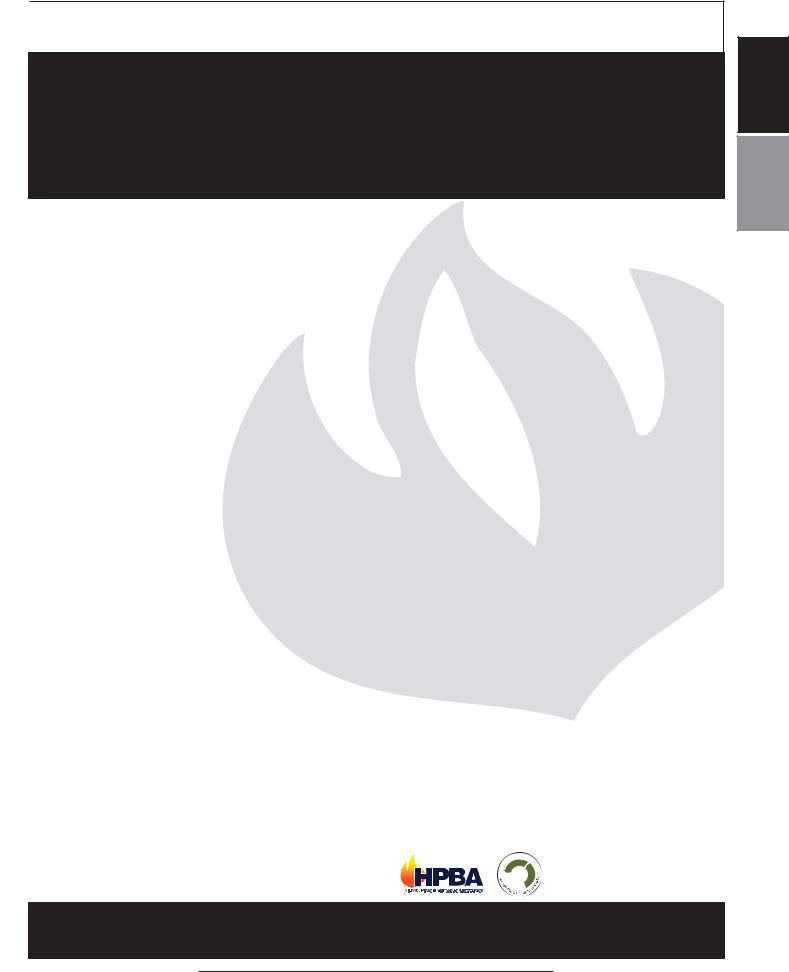
INSTALLER: LEAVE THIS MANUAL WITH THE APPLIANCE.
CONSUMER: RETAIN THIS MANUAL FOR FUTURE REFERENCE.
NEVER LEAVE CHILDREN OR OTHER AT RISK INDIVIDUALS ALONE WITH THE APPLIANCE
INSTALLATION AND
OPERATING INSTRUCTIONS
CONFORMS TO AMERICAN NATIONAL STANDARDS: ANSI Z21.50, CERTIFIED TO CANADIAN CSA 2.22 FOR VENTED GAS FIREPLACES.
CERTIFIED FOR CANADA AND UNITED STATES USING ANSI/CSA METHODS.
SAFETY INFORMATION
! WARNING
If the information in these instructions are not followed exactly, a fire or explosion may result causing property damage, personal injury or loss of life.
-Do not store or use gasoline or other flammable vapors and liquids in the vicinity of this or any other appliance.
-WHAT TO DO IF YOU SMELL GAS:
•Do not try to light any appliance.
•Do not touch any electrical switch; do not use any phone in your building.
•Immediately call your gas supplier from a neighbour’s phone. Follow the gas supplier’s instructions.
•If you cannot reach your gas supplier, call the fire department.
- Installation and service must be performed by a qualified installer, service agency or the supplier.
This appliance may be installed in an aftermarket, permanently located, manufactured home (USA only) or mobile home, where not prohibited by local codes.
This appliance is only for use with the type of gas indicated on the rating plate. This appliance is not convertible for use with other gases, unless a certified kit is used.
Decorative Product: Not for use as a heating appliance.
B36NT / B36NTE &
GX36NT / GX36NTE
NATURAL GAS MODEL
B36PT / B36PTE &
GX36PT / GX36PTE
PROPANE GAS MODEL
SAFETY |
BARRIER |
|
|
|
|
B36 |
ILLUSTRATED |
|
|
||
! DANGER
HOT GLASS WILL CAUSE
BURNS.
DO NOT TOUCH GLASS UNTIL COOLED.
NEVER ALLOW CHILDREN TO TOUCH GLASS.
A barrier designed to reduce the risk of burns from the hot viewing glass is provided with this appliance and shall be installed for the protection of children and other at-risk individuals.
BARRIER
Wolf Steel Ltd., 24 Napoleon Rd., Barrie, ON, L4M 0G8 Canada /
103 Miller Drive, Crittenden, Kentucky, USA, 41030
Phone (705)721-1212 • Fax (705)722-6031 • www.napoleonfireplaces.com • hearth@napoleonproducts.com
$10.00
1.28F
EN
FR PG 81
W415-1401 / C / 03.18.15

2
|
|
|
|
TABLE OF CONTENTS |
|
|
|
|
|
|
|
EN |
|
|
NOTE: The camera icon indicates video tutorials are available as additional reference, visit |
|
|
|
|
|
|||
|
|
http://www.napoleonfireplaces.com/category/product-support/support-centre/ |
|
||
|
1.0 |
|
INSTALLATION OVERVIEW |
3 |
|
|
2.0 |
|
INTRODUCTION |
4 |
|
|
|
|
2.1 |
B36 / GX36 DIMENSIONS |
5 |
|
|
|
2.2 |
GENERAL INSTRUCTIONS |
6 |
|
|
|
2.3 |
GENERAL INFORMATION |
7 |
|
|
|
2.4 |
RATING PLATE INFORMATION |
8 |
3.0 |
|
VENTING |
9 |
||
|
|
|
3.1 |
VENTING LENGTHS AND COMPONENTS |
10 |
|
|
|
3.2 |
TYPICAL VENT INSTALLATION |
11 |
|
|
|
3.3 |
SPECIAL VENT INSTALLATIONS |
13 |
|
|
|
3.3.1 |
PERISCOPE TERMINATION |
13 |
|
|
|
3.3.2 |
CORNER TERMINATION |
13 |
|
|
|
3.4 |
MINIMUM AIR TERMINAL LOCATION CLEARANCES |
14 |
|
|
|
3.5 |
VENTING APPLICATION FLOW CHART |
15 |
|
|
|
3.6 |
DEFINITIONS |
16 |
|
|
|
3.7 |
ELBOW VENT LENGTH VALUES |
16 |
|
|
|
3.8 |
TOP EXIT HORIZONTAL TERMINATION |
17 |
|
|
|
3.9 |
REAR EXIT HORIZONTAL TERMINATION |
19 |
|
|
|
3.10 |
TOP OR REAR EXIT VERTICAL TERMINATION |
21 |
|
|
|
3.11 |
REAR EXIT |
23 |
|
|
|
3.12 |
TOP EXIT |
24 |
4.0 |
|
INSTALLATION |
25 |
||
|
|
|
4.1 |
WALL AND CEILING PROTECTION |
25 |
|
|
|
4.1.1 |
HORIZONTAL INSTALLATION |
26 |
|
|
|
4.1.2 |
VERTICAL INSTALLATION |
26 |
|
|
|
4.2 |
USING FLEXIBLE VENT COMPONENTS |
27 |
|
|
|
4.2.1 |
HORIZONTAL AIR TERMINAL INSTALLATION |
27 |
|
|
|
4.2.2 |
VERTICAL AIR TERMINAL INSTALLATION |
28 |
|
|
|
4.2.3 |
APPLIANCE VENT CONNECTION |
29 |
|
|
|
4.3 |
USING RIGID VENT COMPONENTS |
29 |
|
|
|
4.3.1 |
HORIZONTAL AIR TERMINAL INSTALLATION |
29 |
|
|
|
4.3.2 |
VERTICAL AIR TERMINAL INSTALLATION |
30 |
|
|
|
4.4 |
RESTRICTING VERTICAL VENTS |
30 |
|
|
|
4.5 |
VERTICAL THROUGH EXISTING CHIMNEY |
31 |
|
|
|
4.6 |
MOBILE HOME INSTALLATION |
32 |
|
|
|
4.7 |
GAS INSTALLATION |
33 |
|
|
|
4.8 |
OPTIONAL WALL SWITCH |
33 |
5.0 |
|
FRAMING |
34 |
||
|
|
|
5.1 |
B36 FRAMING |
34 |
|
|
|
5.1.1 |
MINIMUM FRAMING DIMENSIONS B36 |
35 |
|
|
|
5.2 |
MINIMUM ENCLOSURE CLEARANCES |
37 |
|
|
|
5.3 |
GX36 FRAMING |
41 |
|
|
|
5.3.1 |
MINIMUM FRAMING DIMENSIONS GX36 |
42 |
|
|
|
5.4 |
ALCOVE CLEARANCES |
48 |
|
|
|
5.5 |
NON-COMBUSTIBLE FACING MATERIAL |
49 |
|
|
|
5.6 |
MINIMUM MANTEL CLEARANCES |
50 |
|
|
|
5.7 |
NAILING TAB INSTALLATION |
50 |
6.0 |
|
FINISHING |
51 |
||
|
|
|
6.1 |
SAFETY SCREEN & DOOR REMOVAL / INSTALLATION |
51 |
|
|
|
6.2 |
LOG PLACEMENT |
52 |
|
|
|
6.3 |
LOGO PLACEMENT |
53 |
|
|
|
6.4 |
BATTERY BACK-UP INSTALLATION |
53 |
|
|
|
6.5 |
BLOWER INSTALLATION |
54 |
|
|
|
6.6 |
WIRING DIAGRAM (ELECTRONIC) |
55 |
7.0 |
|
OPERATION |
56 |
||
|
|
|
7.1 |
B36NTRE/GX36NTRE & B36PTRE/GX36PTRE (ELECTRONIC) |
56 |
8.0 |
|
OPERATION |
57 |
||
|
|
|
8.1 |
B36NTR/GX36NTR & B36PTR/GX36PTR (MILLIVOLT) |
57 |
9.0 |
|
ADJUSTMENT |
58 |
||
|
|
|
9.1 |
PILOT BURNER ADJUSTMENT |
58 |
|
|
|
9.2 |
VENTURI ADJUSTMENT |
58 |
|
|
|
9.3 |
FLAME CHARACTERISTICS |
59 |
10.0 |
MAINTENANCE |
59 |
|||
|
|
|
10.2 |
DOOR GLASS REPLACEMENT |
60 |
|
|
|
10.1 |
ANNUAL MAINTENANCE |
60 |
|
|
|
10.3 |
CARE OF GLASS |
61 |
11.0 |
REPLACEMENTS |
61 |
|||
12.0 |
B36 OVERVIEW |
62 |
|||
13.0 |
B36 ELECTRONIC VALVE TRAIN ASSEMBLY |
63 |
|||
14.0 |
B36 MILLIVOLT VALVE TRAIN ASSEMBLY |
64 |
|||
15.0 |
B36 ACCESSORIES |
65 |
|||
16.0 |
GX36 OVERVIEW |
66 |
|||
NOTE: Changes, other than editorial, are denoted by a vertical line in the margin.
W415-1401 / C / 03.18.15
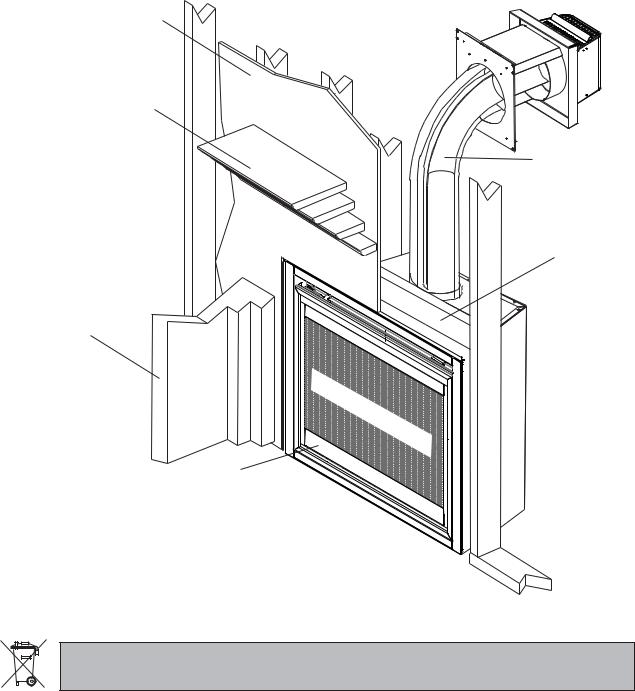
3
17.0 |
GX36 MILLIVOLT VALVE TRAIN ASSEMBLY |
67 |
|
|
|||
18.0 |
GX36 ELECTRONIC VALVE TRAIN ASSEMBLY |
68 |
|
19.0 |
GX36 ACCESSORIES |
69 |
|
20.0 |
TROUBLESHOOTING (ELECTRONIC) |
71 |
EN |
21.0 |
TROUBLESHOOTING (MILLIVOLT) |
74 |
|
22.0 |
WARRANTY |
77 |
|
23.0 |
SERVICE HISTORY |
78 |
|
24.0 |
NOTES |
79 |
|
|
1.0 INSTALLATION OVERVIEW
See the section “MINIMUM ENCLOSURE CLEARANCES” for drywall (or other combustible material).
See the section “MINIMUM
MANTEL CLEARANCES”.
See the section “NON-COMBUSTIBLE  FINISHING”.
FINISHING”.
Side
Wall
See the section “RATING PLATE INFORMATION”.
See the section “VENTING” and “INSTALLATION”.
See the section “FRAMING”.
SAFETY |
BARRIER |
|
|
|
|
B36 |
ILLUSTRATED |
|
|
||
Batteries must be disposed of according to the local laws and regulations. Some batteries may be recycled, and may be accepted for disposal at your local recycling center. Check with your municipality for recycling instructions.
W415-1401 / C / 03.18.15

4
2.0 INTRODUCTION
EN |
! WARNING |
•THIS APPLIANCE IS HOT WHEN OPERATED AND CAN CAUSE SEVERE BURNS IF CONTACTED.
•ANY CHANGES TO THIS APPLIANCE OR IT’S CONTROLS CAN BE DANGEROUS AND IS PROHIBITED.
•Do not operate appliance before reading and understanding operating instructions. Failure to operate appliance according to operating instructions could cause fire or injury.
•Risk of fire or asphyxiation do not operate appliance with fixed glass removed.
•Do not connect 110 volts to the control valve.
•Risk of burns. The appliance should be turned off and cooled before servicing.
•Do not install damaged, incomplete or substitute components.
•Risk of cuts and abrasions. Wear protective gloves and safety glasses during installation. Sheet metal edges may be sharp.
•Do not burn wood or other materials in this appliance.
•Children and adults should be alerted to the hazards of high surface temperature and should stay away to avoid burns or clothing ignition.
•Young children should be carefully supervised when they are in the same room as the appliance. Toddlers, young children and others may be susceptible to accidental contact burns. A physical barrier is recommended if there are at risk individuals in the house. To restrict access to an appliance or stove, install an adjustable safety gate to keep toddlers, young children and other at risk individuals out of the room and away from hot surfaces.
•Clothing or other flammable material should not be placed on or near the appliance.
•Due to high temperatures, the appliance should be located out of traffic and away from furniture and draperies.
•Ensure you have incorporated adequate safety measure to protect infants/toddlers from touching hot surfaces.
•Even after the appliance is out, the glass and/or screen will remain hot for an extended period of time.
•Check with your local hearth specialty dealer for safety screens and hearth guards to protect children from hot surfaces. These screens and guards must be fastened to the floor.
•Any safety screen, guard or barrier removed for servicing the appliance, must be replaced prior to operating the appliance.
•The appliance is a vented gas-fired appliance. Do not burn wood or other materials in the appliance.
•The appliance area must be kept clear and free from combustible materials, gasoline and other flammable vapors and liquids.
•Under no circumstances should this appliance be modified.
•This appliance must not be connected to a chimney flue pipe serving a separate solid fuel burning appliance.
•Do not use this appliance if any part has been under water. Immediately call a qualified service technician to inspect the appliance and to replace any part of the control system and any gas control which has been under water.
•Do not operate the appliance with the glass door removed, cracked or broken. Replacement of the glass should be done by a licensed or qualified service person.
•Do not strike or slam shut the appliance glass door.
•When equipped with pressure relief doors, they must be kept closed while the appliance is operating to prevent exhaust fumes containing carbon monoxide, from entering into the home. Temperatures of the exhaust escaping through these openings can also cause the surrounding combustible materials to overheat and catch fire.Only doors / optional fronts certified with the unit are to be installed on the appliance.
•Only doors / optional fronts certified with the unit are to be installed on the appliance.
•Keep the packaging material out of reach of children and dispose of the material in a safe manner. As with all plastic bags, these are not toys and should be kept away from children and infants.
•As with any combustion appliance, we recommend having your appliance regularly inspected and serviced as well as having a Carbon Monoxide Detector installed in the same area to defend you and your family against Carbon Monoxide.
•Ensure clearances to combustibles are maintained when building a mantel or shelves above the appliance. Elevated temperatures on the wall or in the air above the appliance can cause melting, discolouration or damage to decorations, a T.V. or other electronic components.
•A barrier designed to reduce the risk of burns from the hot viewing glass is provided with this appliance and shall be installed.
•If the barrier becomes damaged, the barrier shall be replaced with the manufacturer’s barrier for this appliance.
•Installation and repair should be done by a qualified service person. The appliance should be inspected before use and at least annually by a professional service person. More frequent cleaning may be required due to excessive lint from carpeting, bedding material, etc. It is imperative that control compartments, burners and circulating air passageways of the appliance be kept clean.
•This appliance uses and requires a fast acting thermocouple. Replace only with a fast acting thermocouple supplied by Wolf Steel
Ltd. |
3.1D |
|
W415-1401 / C / 03.18.15

5
2.1B36 / GX36 DIMENSIONS
|
15 3/4" |
EN |
|
400mm |
|
|
9 1/16" |
|
|
230mm |
|
|
|
15 3/8" |
|
|
391mm |
SAFETY BARRIER |
34 1/16" |
|
866mm |
|
|
|
|
|
|
24" |
|
|
610mm |
4" [102mm] |
|
GAS |
7" [178mm] |
|
INLET |
|
|
9 1/16" |
|
|
|
|
|
|
230mm |
35" |
8" |
|
890mm |
203mm |
35" |
1 15/16" |
||
|
49mm |
889mm |
W415-1401 / C / 03.18.15
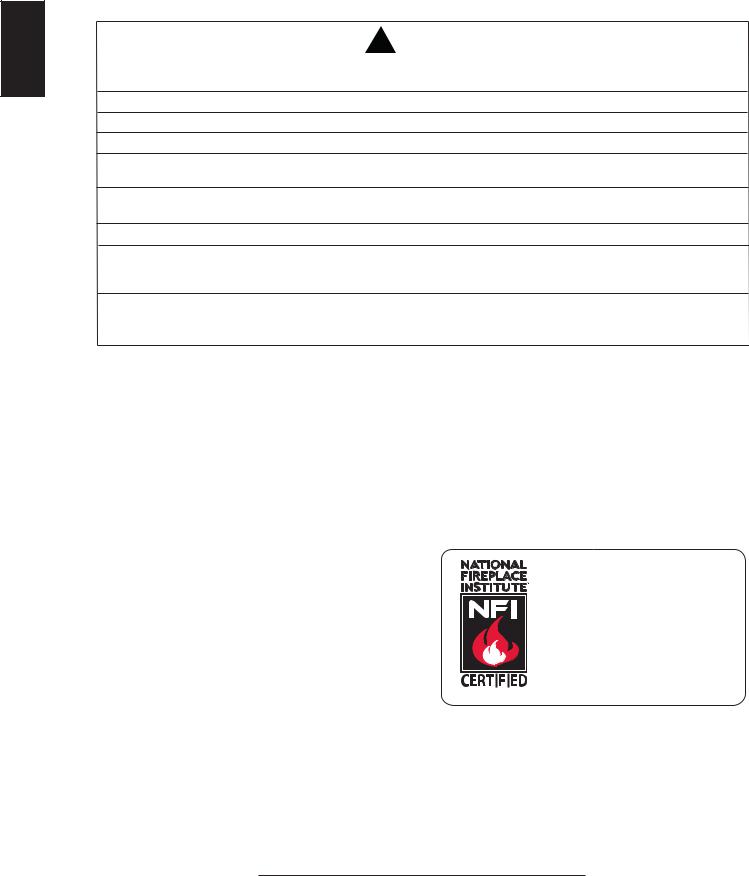
6
2.2GENERAL INSTRUCTIONS
EN |
! WARNING |
ALWAYS LIGHT THE PILOT WHETHER FOR THE FIRST TIME OR IF THE GAS SUPPLY HAS RUN OUT,
WITH THE GLASS DOOR OPENED OR REMOVED.
PROVIDE ADEQUATE CLEARANCE FOR SERVICING AND OPERATING THE APPLIANCE.
PROVIDE ADEQUATE VENTILATION.
NEVER OBSTRUCT THE FRONT OPENING OF THE APPLIANCE.
OBJECTS PLACED IN FRONT OF THE APPLIANCE MUST BE KEPT A MINIMUM OF 48” (1219mm) FROM
THE FRONT FACE OF THE APPLIANCE.
SURFACES AROUND AND ESPECIALLY ABOVE THE APPLIANCE CAN BECOME HOT. AVOID CONTACT
WHEN THE APPLIANCE IS OPERATING.
FIRE RISK. EXPLOSION HAZARD.
HIGH PRESSURE WILL DAMAGE VALVE. DISCONNECT GAS SUPPLY PIPING BEFORE PRESSURE TESTING GAS LINE AT TEST PRESSURES ABOVE 1/2 PSIG. CLOSE THE MANUAL SHUT-OFF VALVE BEFORE PRESSURE TESTING GAS LINE AT TEST PRESSURES EQUAL TO OR LESS THAN 1/2 PSIG (35 mb).
USE ONLY WOLF STEEL APPROVED OPTIONAL ACCESSORIES AND REPLACEMENT PARTS WITH THIS APPLIANCE. USING NON-LISTED ACCESSORIES (BLOWERS, DOORS, LOUVRES, TRIMS, GAS COMPONENTS, VENTING COMPONENTS, ETC.) COULD RESULT IN A SAFETY HAZARD AND WILL VOID THE WARRANTY AND CERTIFICATION.
THIS GAS APPLIANCE SHOULD BE INSTALLED AND SERVICED BY A QUALIFIED INSTALLER to conform with local codes. Installation practices vary from region to region and it is important to know the specifics that apply to your area, for example in Massachusetts State:
•This product must be installed by a licensed plumber or gas fitter when installed within the commonwealth of Massachusetts.
•The appliance damper must be removed or welded in the open position prior to installation of an appliance insert or gas log.
•The appliance off valve must be a “T” handle gas cock.
•The flexible connector must not be longer than 36 inches (914mm).
•A Carbon Monoxide detector is required in all rooms containing gas fired appliances.
•The appliance is not approved for installation in a bedroom or bathroom unless the unit is a direct vent sealed combustion product.
The installation must conform with local codes or, in absence of local codes, the National Gas and Propane Installation Code CSA B149.1 in Canada, or the National Fuel Gas Code, ANSI Z223.1 / NFPA 54 in the United States. Suitable for mobile home installation if installed in accordance with the current standard CAN/CSA Z240MH Series, for gas equipped mobile homes, in Canada or ANSI Z223.1 and NFPA 54 in the United States.
As long as the required clearance to combustibles is
maintained, the most desirable and beneficial location www.nficertified.org for an appliance is in the center of a building, thereby
allowing the most efficient use of the heat created. The location of windows, doors and the traffic flow in the room where the appliance is to be located should be considered. If possible, you should choose a location where the vent will pass through the house without cutting a floor or roof joist.
If the appliance is installed directly on carpeting, vinyl tile or other combustible material other than wood flooring, the appliance shall be installed on a metal or wood panel extending the full width and depth.
Some appliances have optional fans or blowers. If an optional fan or blower is installed, the junction box must be electrically connected and grounded in accordance with local codes, use the current CSA C22.1 Canadian
Electrical Code in Canada or the ANSI/NFPA 70 National Electrical code in the United States.
4.1B
W415-1401 / C / 03.18.15

7
2.3GENERAL INFORMATION
FOR YOUR SATISFACTION, THIS APPLIANCE HAS BEEN TEST-FIRED TO ASSURE ITS OPERATION AND |
|||||||
|
QUALITY! |
|
|
|
EN |
||
|
RATES AND EFFICIENCIES |
|
|
|
|
||
|
B36 |
|
GX36 |
|
|
||
|
|
|
|
|
|
|
|
|
NG |
|
LP |
NG |
LP |
|
|
Altitude (FT) |
0-4,500 |
|
0-4500 |
0-4,500 |
0-4500 |
|
|
Max. Input (BTU/HR) |
18,000 |
|
18,000 |
26,000 |
26,000 |
|
|
Min. Inlet Gas Supply Pressure |
4.5" (11mb) w.c. |
|
11" (27mb) w.c. |
4.5" (11mb) w.c. |
11" (27mb) w.c. |
|
|
Max. Inlet Gas Supply |
7" (17mb) w.c. |
|
13" (32mb) w.c. |
7" (17mb) w.c. |
13" (32mb) w.c. |
|
|
Pressure |
|
|
|
|
|
|
|
Manifold Pressure (Under Flow |
3.5" (9mb) w.c. |
|
10" (25mb) w.c. |
3.5" (9mb) w.c. |
10" (25mb) w.c. |
|
|
Conditions) |
|
|
|
|
|
|
|
|
|
|
|
|
|
|
|
This appliance is approved for bathroom, bedroom and bed-sitting room installations and is suitable for mobile home installation.
No external electricity (110 volts or 24 volts) is required for the gas millivolt system operation.
Expansion / contraction noises during heating up and cooling down cycles are normal and are to be expected.
A barrier designed to reduce the risk of burns from the hot viewing glass is provided with the appliance and must be installed.
W415-1401 / C / 03.18.15
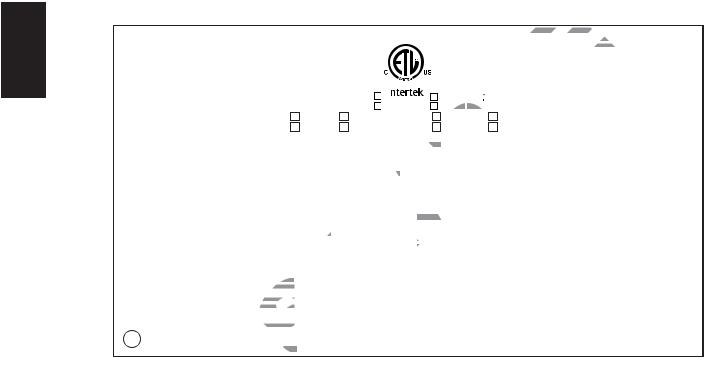
8
2.4
EN
RATING PLATE INFORMATION
INSTALLER: It is your responsibilitySto check off the appropriate box on the rating plate according to the model, venting and gas type of the appliance.
CONFORMS TO / CONFORME AUX: ANSI Z21.50-2014, CERTIFIED TO / CERTIFIE CSA 2.22-2014 VENTED GAS FIR |
PLA |
CE / FOYER À GAZ VENTILÉ. |
|||||||||||
DIRECT VENT GAS FIREPLACE. SUITABLE FOR BEDROOM, BATHROOM AND BED-SITTING ROOM |
FOYER À GAZ VENTILÉ DIR CT. HOMOLOGUE POUR INSTALLATION D |
ANS UNE CHAMBRE A COUCHER, |
|||||||||||
INSTALLATION. SUITABLE FOR MOBILE HOME INSTALLATION IF INSTALLED IN ACCORDANCE |
UNE SALLE DE BAIN ET UN STUDIO. APPROPRIE POUR INSTALLATION |
DANS UNE MAISON MOBILE SI |
|||||||||||
WITH THE CURRENT STANDARD CAN/CSA Z240MH SERIES GAS EQUIPPED MOBILE HOMES, |
SON INSTALLATION CONFORM |
AUX |
XIG NC S DE LA NORME |
CAN/C |
SA Z240MH SERIE DE MAISONS |
||||||||
IN CANADA OR IN THE UNITED STATES THE MANUFACTURED HOME CONTRUCTION AND |
MOBILES EQUIPEES AU GAZ, |
N VIGU UR AU CANADA OU AUX |
|
|
TS-UNIS DE LA NORME DE |
||||||||
|
TA |
||||||||||||
SAFETY STANDARD, TITLE 24 CFR, PART 3280. WHEN THIS US STANDARD IS NOT |
SECURITE ET DE CONSTRUCTION D MAISONS MANUFACTUR |
|
S, TITRE 24 CFR, SECTION 3280. |
||||||||||
|
|||||||||||||
APPLICABLE USE THE STANDARD FOR FIRE SAFETY CRITERIA FOR MANUFACTURED |
DANS E CAS OU CETTE NORME D' TATS-UNIS NE P UT TRE APPLIQUEE, SE REFERER A LA NORME |
||||||||||||
HOME INSTALLATIONS, SITES AND COMMUNITIES, ANSI / NFPA 501A. FOR USE WITH BARRIER |
RE ATIVE AU CRITERE DE M SUR S DE S CURITE CONTR L'INC NDIE POUR LES INSTALLATIONS |
||||||||||||
W565-0144. FOLLOW THE INSTALLATION INSTRUCTIONS LOCATED IN THE INSTALLATION MANUAL. |
DANS ES MAISONS MANUFACTUR S, |
S SIT S |
T L S COMMUNAUT S, ANSI/NFPA 501A. POUR |
||||||||||
9700539 (WSL) |
4001657 (NGZ)) |
UNE UTI IS R AV C BARRIÈR |
W565-0144. SUIV Z LES INSTRUCTIONS |
||||||||||
|
|
|
|
|
|
|
|||||||
4001658 (NAC) |
4001659 (WUSA) |
D'INSTA |
ATION SE TROUVENT DANS LE MANUEL D'INSTALLATION |
||||||||||
|
|
|
|
|
|
|
|
|
|
|
|||
B36NTR |
CB36NTR MODEL |
CB36PTR |
|
|
|
B36PTR |
|
|
||
B36NTRE |
CB36NTRE |
|
|
|
|
|
|
|
||
|
CB36PTRE |
|
|
|
B36PTRE |
|
||||
0-4500FT (0-1370m) |
ALTITUDE / ELE |
|
|
|
0-4500FT (0-1370m) |
|||||
VATION |
|
|||||||||
18,000 BTU/h |
INPUT / ALIMENTATION |
|
|
8,000 BTU/h |
||||||
|
1 |
|||||||||
13,000 BTU/h |
REDUCED INPUT / ALIMENTATION REDUITE |
13,500 BTU/h |
||||||||
|
|
MANIFOLD PRESSURE: 3.5" (9MB) WATER COLUMN |
|
MANIFOLD |
RESSURE: 10" (25MB) WATER COLUMN |
|
|||||||||||||||||||||||||
|
|
PRESSION AU COLLECTEUR: 3.5" (9 MB) D'UNE COLONNE D'E |
AU |
|
|
RESSION AU COLLECTEUR: 10" (25MB) D'UNE COLONNE D'EAU |
|
||||||||||||||||||||||||
|
|
MINIMUM SUPPLY PRESSURE: 4.5" (11MB) WATER COLUMN |
|
|
MINIMUM SU |
LY RESSURE: 11" (27MB) WATER COLUMN |
|
||||||||||||||||||||||||
|
PRESSION D'ALIMENTATION MINIMALE: 4.5" (11MB) D'UNE COLONNE D'EAU |
|
|
RESSION D'ALIMENTATION MINIMALE: 11" (27MB) D'UNE COLONNE D'EAU |
|
||||||||||||||||||||||||||
|
|
MAXIMUM SUPPLY PRESSURE: 7.0" (17 |
B) WATER |
COLU |
N |
|
AXI UM SU |
LY RESSURE: 13" (32MB) WATER COLUMN |
|
||||||||||||||||||||||
|
PRESSION D'ALIMENTATION MAXIMALE: 7.0" (17MB) D'UNE COLONNE D'EAU |
|
PRESSION D'ALI ENTATION MAXIMALE: 13" (32MB) D'UNE COLONNE D'EAU |
|
|||||||||||||||||||||||||||
|
|
|
|
|
|
|
|
|
|
|
|
|
|
|
|
P4: |
51.7% |
|
|
P4: |
|
51.7% |
|
|
|
|
|
|
|||
NOT FOR USE WITH SOLID FUEL. FOR USE WITH GLASS |
DOORS |
|
|
|
|
|
UN |
CO |
|
BUSTIBLE SOLIDE NE DOIT PAS ETRE UTILISE AVEC CET |
|||||||||||||||||||||
CERTIFIED WITH THIS UNIT ONLY. |
|
|
|
|
|
|
|
|
|
|
|
|
|
|
|
|
APPAREIL. UTILISER AVEC LES PORTES VITREES HOMOLOGUEES |
||||||||||||||
WARNING: THIS FIREPLACE USES AND REQUIRES A FAST ACTING THER OCOUPLE. REPLACE |
|
|
|
ENT AVEC CETTE UNITE. |
|
||||||||||||||||||||||||||
|
SEULE |
|
|||||||||||||||||||||||||||||
ONLY WITH A FAST ACTING THERMOCOUPLE SUPPLIED BY WOLF STEEL LTD. |
|
|
|
|
|
|
|
|
|
|
|
|
AVERTISSE |
ENT: CE FOYER UTILISE ET REQUIERT UN THERMOCOUPLE À ACTION RAPIDE. |
|||||||||||||||||
DO NOT ADD ANY MATERIAL TO THE APPLIANCE, WHICH WILL COME IN CONT CT WITH THE FL |
ES, |
|
|||||||||||||||||||||||||||||
OTHER THAN THAT SUPPLIED BY THE MANUFACTURER WITH THE PPLI NCE. |
INI UM CLE R |
NCE |
|
RE PLACEZ UNIQUEMENT AVEC UN THERMOCOUPLE À ACTION RAPIDE DE WOLF STEEL LTÉE. |
|||||||||||||||||||||||||||
TO COMBUSTIBLE MATERIALS / |
|
|
|
|
|
|
|
|
|
|
|
|
|
|
|
|
|
|
|
N’AJOUTEZ PAS A CET APPAREIL AUCUN MATERIAU DEVANT ENTRER EN CONTACT AVEC LES FLAMMES |
|||||||||||
DEGAGEMENTS MINIMAUX DES MATERIAUX COMBUSTIBLES: |
|
|
|
|
|
|
|
|
|
|
|
AUTRE QUE CELUI QUI EST FOURNI AVEC CET APPAREIL PAR LE FABRICANT. |
|
||||||||||||||||||
TOP/ DESSUS |
0 |
RECESSED DEPTH / PROFONDEUR D'ENC STRE |
16" |
|
|
|
|
|
|
THE APPLIANCE MUST BE VENTED USING THE APPROPRIATE WOLF STEEL VENT KITS. SEE OWNERS |
|||||||||||||||||||||
FLOOR / PLANCHER |
0 |
VENT SIDES / COTES DE L'EVENT |
|
|
|
1" |
|
|
|
|
|
|
|
|
INSTALLATION MANUAL FOR VENTING SPECIFICS. PROPER REINSTALLATION AND RESEALING IS |
|
|||||||||||||||
SIDES / COTES |
0 |
VENT TOP / EVENT SUPERIEUR |
|
|
|
|
|
|
|
|
|
|
|
|
|
NECESSARY AFTER SERVICING THE VENT-AIR INTAKE SYSTEM. |
|
||||||||||||||
|
|
|
3" |
|
|
|
|
|
|
|
|||||||||||||||||||||
BACK / ARRIERE |
0 |
VENT BOTTOM / EVENT |
INFERIEUR |
|
|
|
|
|
|
|
|
|
|
|
L'APPAREIL DOIT EVACUER SES GAZ EN UTILISANT L'ENSEMBLE D'EVACUATION PROPRE A NAPOLEON. |
||||||||||||||||
|
1" |
|
|
|
|
|
|
||||||||||||||||||||||||
MANTEL / MANTEAU |
2" * |
|
|
|
|
|
|
|
|
|
|
|
|
|
|
|
|
|
|
|
|
REFERER AU MANUEL D'INSTALLATION DE PROPRIETAIRE POUR L'EVACUATION PRECISE. IL EST |
|
||||||||
* MAXIMUM HORIZONTAL EXTENSION / L'EXTEN ION HORIZONT |
|
LE M XIM LE: 2". SEE INSTRUCTION |
|
IMPORTANT DE BIEN REINSTALLER ET RESCELLER L'EVENT APRES AVOIR ASSURE LE MAINTIEN DU |
|||||||||||||||||||||||||||
MANUAL FOR GREATER EXTENSIONS. REFERER AU M NUEL |
D'INSTRUCTION POUR DES |
|
|
|
|
|
|||||||||||||||||||||||||
|
|
|
|
|
SYSTEME DE PRISE D'AIR. |
|
|||||||||||||||||||||||||
EXTENSIONS PLUS GRANDES. |
|
|
|
|
|
|
|
|
|
|
|
|
|
|
|
|
|
|
|
|
|
||||||||||
|
|
|
|
|
|
|
|
|
|
|
|
|
|
|
|
|
|
|
|
DECORATIVE PRODUCT: NOT FOR USE AS A HEATING APPLIANCE |
|
||||||||||
SEE OWNER'S INSTRUCTION MANUAL |
|
|
|
|
|
|
AND MAXIMUM VENT LENGTHS. |
|
|
|
|
|
|
||||||||||||||||||
FOR MINIMUM |
|
|
|
|
|
|
|
||||||||||||||||||||||||
|
|
|
|
|
|
PRODUIT DÉCORATIF: NE PAS UTILISER COMME APPPAREIL DE CHAUFFAGE. |
|
||||||||||||||||||||||||
REFERER AU MANUEL D'IN TALLATION |
DE PROPRIETAIRE POUR |
S LONGUEURS |
|
|
|
|
|
|
|||||||||||||||||||||||
|
|
|
|
|
ELECTRICAL RATING / CLASSIFICATION: 115V 0.82AMP, 60HZ |
|
|||||||||||||||||||||||||
D'EVACUATION MINIMALE ET MAXIMALE. |
|
|
|
|
|
|
|
|
|
|
|
|
|
|
|
|
|
||||||||||||||
AMPLE |
|
||||||||||||||||||||||||||||||
WOLF STEEL LTD. |
|
|
|
|
|
|
|
|
|
|
|
|
|
|
|
|
OPTIONAL FAN KIT / ENSEMBLE DE VENTILATEUR FACULTATIF: EP35 |
|
|||||||||||||
|
|
|
|
|
|
|
|
|
|
|
|
|
|
|
SERIAL NUMBER/NO. DE SERIE: |
B36 |
|
|
|||||||||||||
24 NAPOLEON ROAD, BARRIE, ON, L4M 0G8 CANADA |
|
|
|
|
|
|
|
|
|
|
|
|
|
W385-1987 |
|||||||||||||||||
|
|
|
|
|
|
|
|
|
|
|
|
|
|
|
|
|
|
|
|
|
|
|
|
|
|
|
|
|
|
|
|
For rating plate location, see “INSTALLATION OVERVIEW” section.
This illustration is for reference only. Refer to the rating plate on the appliance for accurate information.
NOTE: The rating plate must remain with the appliance at all times. It must not be removed.
W415-1401 / C / 03.18.15
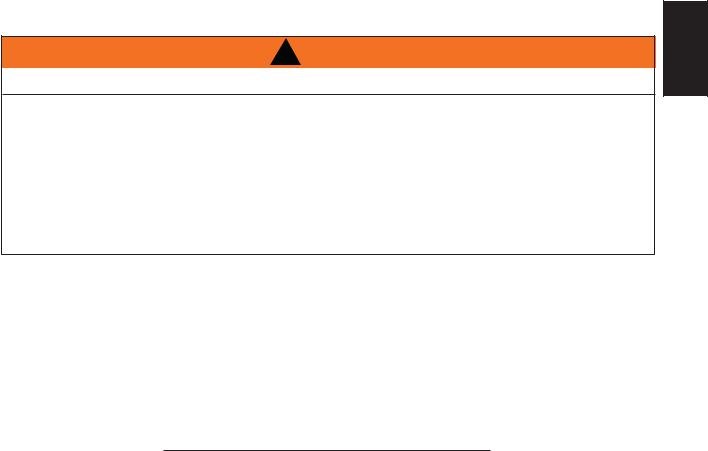
9
3.0 VENTING
! WARNING |
EN |
|
RISK OF FIRE, MAINTAIN SPECIFIED AIR SPACE CLEARANCES TO VENT PIPE AND APPLIANCE.
IF VENTING IS INCLUDED WITH SPACERS THE VENT SYSTEM MUST BE SUPPORTED EVERY 3FT (0.9m) FOR BOTH VERTICAL AND HORIZONTAL RUNS. USE SUPPORTS OR EQUIVALENT NON-COMBUSTIBLE STRAPPING TO MAINTAIN THE REQUIRED CLEARANCE FROM COMBUSTIBLES. USE WOLF STEEL LTD. SUPPORT RING ASSEMBLY W010-0370 OR EQUIVALENT NON-COMBUSTIBLE STRAPPING TO MAINTAIN THE MINIMUM CLEARANCE TO COMBUSTIBLES FOR BOTH VERTICAL AND HORIZONTAL RUNS. SPACERS ARE ATTACHED TO THE INNER PIPE AT PREDETERMINED INTERVALS TO MAINTAIN AN EVEN AIR GAP TO THE OUTER PIPE. THIS GAP IS REQUIRED FOR SAFE OPERATION. A SPACER IS REQUIRED AT THE START, MIDDLE AND END OF EACH ELBOW TO ENSURE THIS GAP IS MAINTAINED. THESE SPACERS MUST NOT BE REMOVED.
THIS APPLIANCE USES A 4” (102mm) EXHAUST / 7” (178mm) AIR INTAKE VENT PIPE SYSTEM. Refer to the section applicable to your installation.
For safe and proper operation of the appliance follow the venting instruction exactly. Deviation from the minimum vertical vent length can create difficulty in burner start-up and/or carboning. Under extreme vent configurations, allow several minutes (5-15) for the flame to stabilize after ignition. Although not a
requirement, it is recommended for vent lengths that pass through unheated spaces (attics, garages, crawl spaces) be insulated with the insulation wrapped in a protective sleeve to minimize condensation. Provide a means for visually checking the vent connection to the appliance after the appliance is installed. Use a firestop, vent pipe shield or attic insulation shield when penetrating interior walls, floor or ceiling.
NOTE: If for any reason the vent air intake system is disassembled; reinstall per the instructions provided for the initial installation.
7.1C
W415-1401 / C / 03.18.15

10
3.1VENTING LENGTHS AND COMPONENTS
Use only Wolf Steel, Simpson Dura-Vent, Selkirk Direct Temp, American Metal Amerivent or Metal-Fab venting EN components. Minimum and maximum vent lengths, for both horizontal and vertical installations, and air terminal
locations for either system are set out in this manual and must be adhered to. For Simpson Dura-Vent, Selkirk Direct Temp, American Metal Amerivent and Metal-Fab follow the installation procedure provided with the venting components.
A starter adaptor must be used with the following vent systems and may be purchased from the corresponding supplier:
PART |
4”/7” |
SUPPLIER |
WEBSITE |
|
|
|
|
Duravent |
W175-0053 |
Wolf Steel |
www.duravent.com |
|
|
|
|
Amerivent |
4DSC-N2 |
American Metal |
www.americanmetalproducts.com |
|
|
|
|
Direct Temp |
4DT-AAN |
Selkirk |
www.selkirkcorp.com |
|
|
|
|
SuperSeal |
4DNA |
Metal-Fab |
www.mtlfab.com |
|
|
|
|
For Simpson Dura-Vent, Selkirk Direct Temp, American Metal Amerivent and Metal-Fab follow the installation procedure found on the website for your venting supplier.
For vent systems that provide seals on the inner exhaust flue, only the outer air intake joints must be sealed using a red high temperature silicone (RTV). This same sealant may be used on both the inner exhaust and outer intake vent pipe joints of all other approved vent systems except for the exhaust vent pipe connection to the appliance flue collar which must be sealed using the black high temperature sealant Mill Pac. High temperature sealant must be ordered separately.
When using Wolf Steel venting components, use only approved Wolf Steel rigid / flexible components with the following termination kits: wall terminal kit GD222, GD222R, or 1/12 to 7/12 pitch roof terminal kit GD110, 8/12 to 12/12 roof terminal kit GD111, flat roof terminal kit GD112 or periscope kit GD201 (for wall penetration below grade). With flexible venting, in conjunction with the various terminations, use either the 5 foot (1.5m) vent kit GD220 or the 10 foot (3.1m) vent kit GD330.
For optimum flame appearance and appliance performance, keep the vent length and number of elbows to a minimum. The air terminal must remain unobstructed at all times. Examine the air terminal at least once a year to verify that it is unobstructed and undamaged.
Rigid and flexible venting systems must not be combined. Different venting manufacturer components must not be combined.
These vent kits allow for either horizontal or vertical venting of the appliance. The maximum allowable horizontal run is
20 feet (6.1m). The maximum allowable vertical vent length is 40 feet (12.2m). The maximum number of vent connections is two horizontally or three vertically (excluding the appliance and the air terminal connections) when using flexible venting.
8.1A
For optimum performance, it is recommended that all horizontal runs have a 1" (25mm) rise per foot.
GX36 REQUIRED RISE ON HORIZONTAL |
|
B36 REQUIRED RISE ON HORIZONTAL |
||||
|
VENTING |
|
|
|
VENTING |
|
Rear Vent |
Rigid Venting |
1" (25mm) / FT** |
|
Rear Vent |
Rigid Venting |
0" / FT |
|
Flexible Venting |
1" (25mm) / FT** |
|
|
Flexible Venting |
0" / FT |
Top Vent |
Rigid Venting |
0" / FT |
|
Top Vent |
Rigid Venting |
0" / FT |
|
Flexible Venting |
0" / FT |
|
|
Flexible Venting |
0" / FT |
Corner Vent |
Rigid Venting |
6" (152mm) |
|
Corner Vent |
Rigid Venting |
0" |
|
Flexible Venting |
6" (152mm) |
|
|
Flexible Venting |
6" (152mm) |
** When a vertical rise is used as part of the venting configuration, a 0" (0mm) rise per foot is acceptable.
W415-1401 / C / 03.18.15
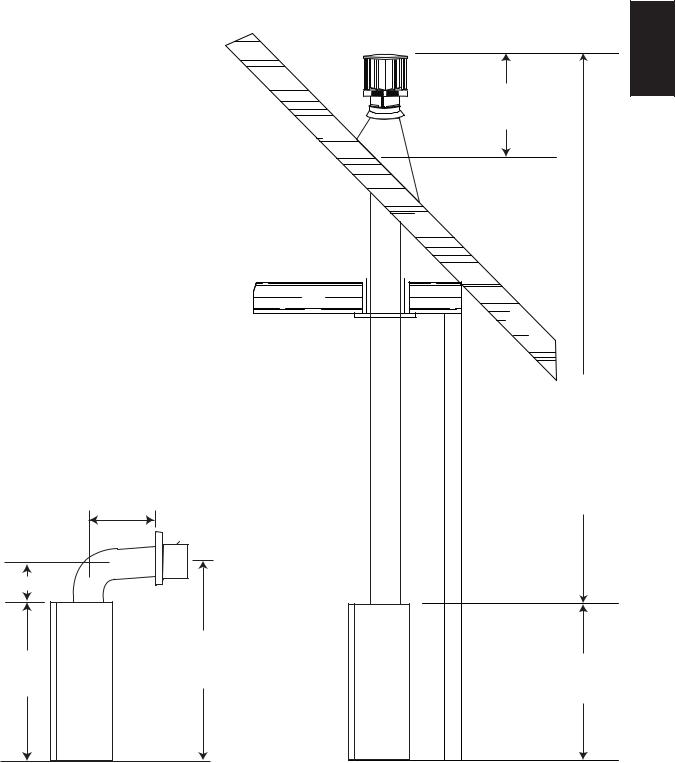
11
3.2TYPICAL VENT INSTALLATION
EN
16" (406MM) MINIMUM
|
|
40 FT (12M) |
|
|
|
MAXIMUM |
|
|
|
3 FT (1M) |
|
|
24" (610MM) |
MINIMUM |
|
|
|
||
|
MAXIMUM |
|
|
8" (203MM) |
|
|
|
MINIMUM |
|
|
|
|
42 1/16" (1068MM) |
|
|
34 1/16" |
MINIMUM PLUS |
34 1/16" |
|
RISE* |
|||
(865MM) |
|||
(865MM) |
|||
|
|||
|
|
||
|
TOP VENT |
|
W415-1401 / C / 03.18.15
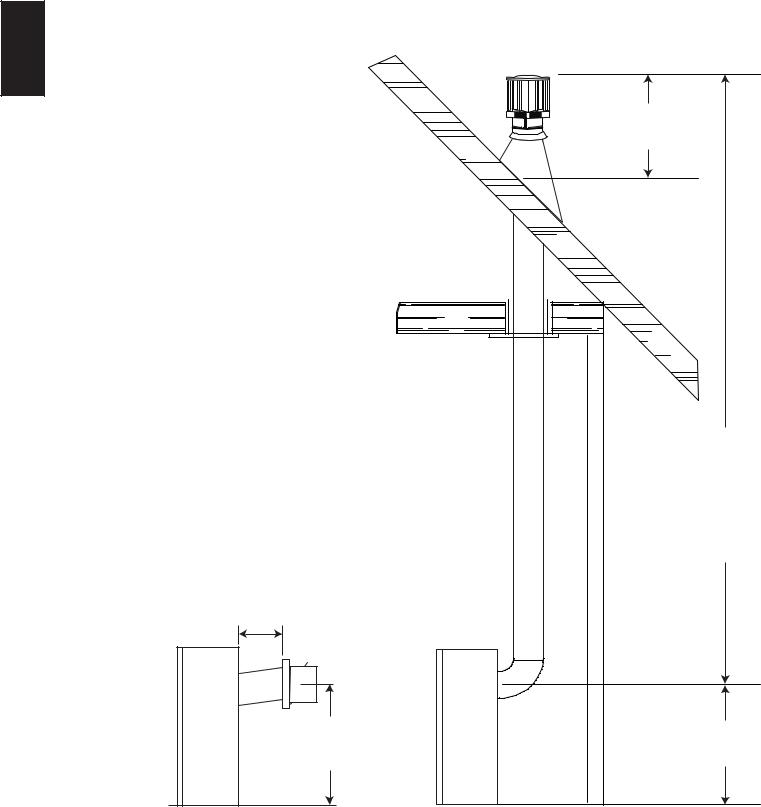
12
EN
16" (406MM) MINIMUM
20"
(508MM) MAX
24" |
(610MM) |
PLUS RISE |
40 FT (12M) |
MAXIMUM |
3 FT (1M) |
MINIMUM |
24" |
(610MM) |
REAR VENT
W415-1401 / C / 03.18.15
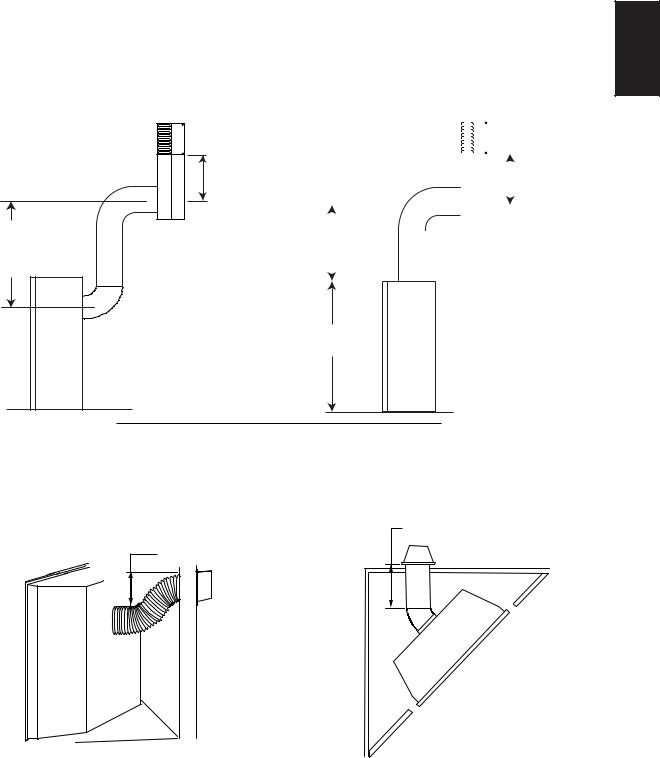
13
3.3 SPECIAL VENT INSTALLATIONS
3.3.1 PERISCOPE TERMINATION
EN
Use the periscope kit to locate the air termination above grade. The periscope must be installed so that when final grading is completed, the bottom air slot is located a minimum 12” (304.8mm) above grade. The maximum allowable vent length is 10’ (3.1m) for a fireplace and 8’ (2.4m) for a stove.
30" (762MM) |
MINIMUM |
12" (305MM) |
|
|
|
|
|
|
|
|
|
|
|
|
|
|
|
|
12" (305MM) |
|
|
|
|
|
|
|
|
|
|
|
|
|
|
|
|
||
|
|
|
|
|
|
|
|
|
|
|
|
|
|
|
|
||
|
|
|
|
|
|
|
|
|
|
|
|
|
|
|
|
||
|
|
|
|
|
|
|
|
|
|
|
|
|
|
|
|
||
|
|
|
|
|
|
|
|
|
|
|
|
|
|
|
|
||
|
|
|
|
|
|
|
|
|
|
|
|
|
|
|
|
||
|
|
|
|
|
|
|
|
|
|
|
|
|
|
|
|
||
|
|
|
|
|
|
|
|
|
|
|
|
|
|
|
|
||
|
|
|
|
|
|
|
|
|
|
|
|
|
|
|
|
||
|
|
|
|
|
|
|
|
|
|
|
|
|
|
|
|
||
|
|
|
|
|
|
|
|
|
|
|
|
|
|
|
|
||
MINIMUM |
|
|
|
|
|
|
|
|
|
|
|
|
|
|
|
|
MINIMUM |
TO GRADE |
|
|
|
|
|
|
|
|
|
|
|
|
|
|
|
|
TO GRADE |
|
|
|
|
|
|
|
|
|
|
|
|
|
|
|
|
||
|
|
|
|
|
|
|
|
|
|
|
|
|
|
||||
|
|
|
|
|
|
|
|
|
|
|
|
|
|
|
|
|
|
|
30" (762MM) |
|
|
|
|
|
|
|
|
|
|
|
|||||
|
|
||||||||||||||||
|
MINIMUM |
|
|
|
|
|
|
|
|
|
|
|
|||||
|
|
|
|
|
|
|
|
|
|
|
|
|
|
|
|
|
|
|
|
|
|
|
|
|
|
|
|
|
|
|
|
|
|
|
|
|
|
|
|
|
|
|
|
|
|
|
|
|
|
|
|
|
|
34 1/16" (865MM)
9.4A
3.3.2 CORNER TERMINATION
The maximum vent length for a corner installation is 20" (508mm) of horizontal run, in addition to the 45° offset. In this case zero rise is acceptable. However, it is recommended a 6" (152mm) rise be included. See illustrations below:
6” (152.4mm) RISE
W415-1401 / C / 03.18.15
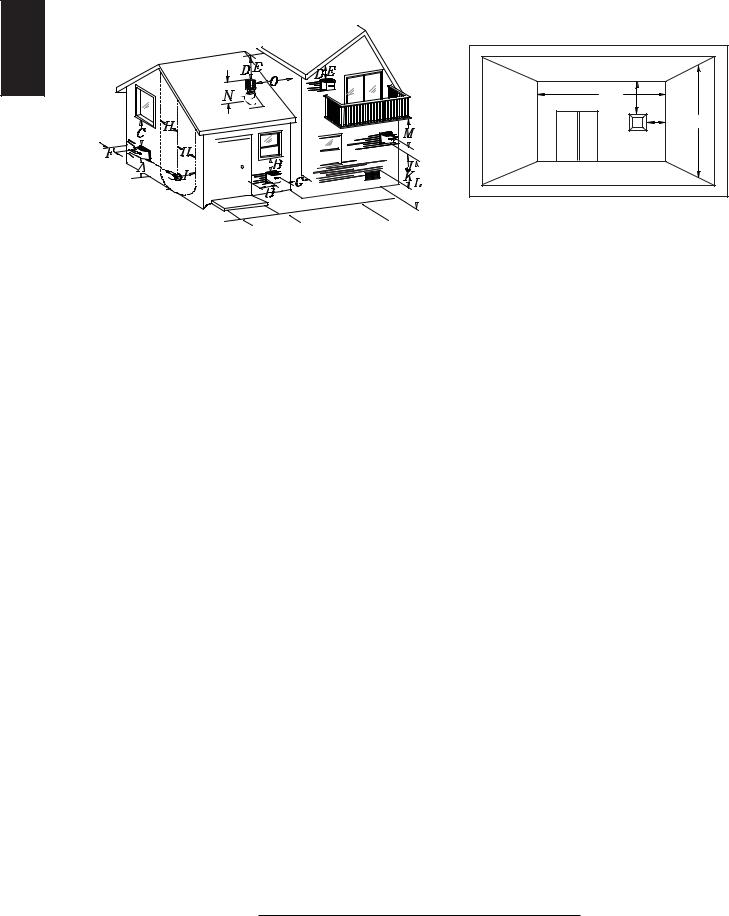
14
3.4MINIMUM AIR TERMINAL LOCATION CLEARANCES
COVERED BALCONY APPLICATIONS ††*
EN
Q S
P
 R
R  G
G
|
|
|
|
|
|
|
|
|
|
|
|
|
|
|
|
|
|
|
|
|
|
|
|
|
|
|
|
|
|
|
|
|
|
|
|
|
|
|
|
|
|
|
|
|
|
|
|
|
|
|
|
|
|
|
|
|
|
|
|
|
|
|
|
|
|
|
|
|
|
|
|
|
|
|
|
|
|
|
|
|
|
|
|
|
|
|
|
|
|
|
|
|
|
|
|
|
|
|
|
|
|
|
|
|
|
|
|
|
|
|
|
|
|
|
|
|
|
|
|
|
|
|
|
|
|
|
|
|
|
|
|
|
|
|
|
|
|
|
|
|
|
|
|
|
|
|
|
|
|
|
|
|
|
|
|
|
|
|
|
|
|
|
|
|
|
|
|
|
|
|
|
|
|
|
|
|
|
|
|
|
|
|
|
|
|
|
|
|
|
|
|
|
|
|
|
|
|
|
|
|
QMIN = 3 feet |
R MAX = 2 x QACTUAL |
RMAX IHHW |
|
|
|
|
|
|
|
|
|
|
|
|
|
|
|
|
|
|
|
|
|
|
|
|
|
|
|
|
|
|
|
|
|
|
|
|
|
|||||
|
|
|
|
|
|
|
|
|
|
|
|
|
|
|
|
|
|
|
|
|
|
|
|
|
|
|
|
|
|
|
|
|
|
|
|
|
(0.9m) |
|
(4.6m) |
|
|
|
|
|
|
|
|
|
|
INSTALLATIONS |
|
|
|
|
|
|
|
|
|
|
|
|
|
|
|
|
|||||||||||||||
|
|
|
|
|
|
|
CANADA |
|
|
U.S.A. |
|
|
|
|
|
|
|
|
|
|
|
|
|
|
|
|
||||||||||||||
|
A |
|
|
12” (305mm) |
12” (305mm) |
Clearance above grade, veranda porch, deck or balcony. |
|
|
||||||||||||||||||||||||||||||||
|
|
|
|
|
|
|
|
|
|
|
|
|
|
|
|
|
|
|
|
|
|
|
|
|
|
|
|
|
|
|
|
|
|
|
|
|
|
|
|
|
|
B |
12” (305mm) |
|
|
9” |
Clearance to windows or doors that open. |
|
|
||||||||||||||||||||||||||||||||
|
|
|
(229mm) |
|
|
|||||||||||||||||||||||||||||||||||
|
|
|
|
|
|
|
|
|
|
|
|
|
|
|
|
|
|
|
|
|
|
|
|
|
|
|
|
|
|
|
|
|||||||||
|
C |
12” (305mm)* |
12” (305mm) * |
Clearance to permanently closed windows. |
|
|
||||||||||||||||||||||||||||||||||
|
|
|
|
|
|
|
|
|
|
|
|
|
|
|
|
|
|
|
|
|
|
|
|
|
|
|
|
|
|
|
|
|
|
|
|
|
|
|
|
|
|
D |
|
|
|
|
|
|
18” |
18” (457mm)** |
Vertical clearance to ventilated soffits located above the terminal within a horizontal distance of 2’ |
||||||||||||||||||||||||||||||
|
|
|
|
(457mm)** |
(0.6m) from the center line of the terminal. |
|
|
|||||||||||||||||||||||||||||||||
|
E |
12” (305mm)** |
12” (305mm)** |
Clearance to unventilated soffit. |
|
|
||||||||||||||||||||||||||||||||||
|
F |
|
|
|
|
0” (0mm) |
|
|
0” (0mm) |
Clearance to an outside corner wall. |
|
|
||||||||||||||||||||||||||||
|
|
|
|
|
0” (0mm)*** |
|
|
0” |
Clearance to an inside non-combustible corner wall or protruding non-combustible obstructions (chimney, |
|||||||||||||||||||||||||||||||
|
|
|
|
|
|
|
(0mm)*** |
etc.). |
|
|
||||||||||||||||||||||||||||||
G |
|
|
|
|
|
|
|
|
|
|
|
|
|
|
|
|||||||||||||||||||||||||
|
2” (51mm)*** |
|
|
2” |
Clearance to an inside combustible corner wall or protruding combustible obstructions (vent chase, |
|||||||||||||||||||||||||||||||||||
|
|
|
|
|
|
|||||||||||||||||||||||||||||||||||
|
|
|
|
|
|
(51mm)*** |
etc.). |
|
|
|||||||||||||||||||||||||||||||
|
|
|
|
|
|
|
|
|
|
|
|
|
|
|
|
|
|
|||||||||||||||||||||||
|
H |
|
|
|
|
3’(0.9m) |
|
3’ (0.9m)**** |
Clearance to each side of the center line extended above the meter / regulator assembly to a |
|||||||||||||||||||||||||||||||
|
|
|
|
|
|
maximum vertical distance of 15’ (4.6m). |
|
|
||||||||||||||||||||||||||||||||
|
|
|
|
|
|
|
|
|
|
|
|
|
|
|
|
|
|
|
|
|
|
|
|
|
|
|
||||||||||||||
|
I |
|
|
|
|
3’ (0.9m) |
|
3’ (0.9m)**** |
Clearance to a service regulator vent outlet. |
|
|
|||||||||||||||||||||||||||||
|
J |
|
|
12” (305mm) |
|
9” (229mm) |
Clearance to a non-mechanical air supply inlet to the building or a combustion air inlet to any other |
|||||||||||||||||||||||||||||||||
|
|
|
|
appliance. |
|
|
||||||||||||||||||||||||||||||||||
|
|
|
|
|
|
|
|
|
|
|
|
|
|
|
|
|
|
|
|
|
|
|
|
|
|
|
||||||||||||||
|
K |
|
|
|
|
6’ (1.8m) |
|
|
3’ (0.9m) † |
Clearance to a mechanical air supply inlet. |
|
|
||||||||||||||||||||||||||||
|
L |
|
|
|
7’ (2.1m) ‡ |
7’ (2.1m) **** |
Clearance above a paved sidewalk or paved driveway located on public property. |
|||||||||||||||||||||||||||||||||
M |
|
|
|
|
|
|
12” |
|
|
12” |
Clearance under a veranda, porch or deck. |
|
|
|||||||||||||||||||||||||||
|
|
|
(305mm)†† |
|
(305mm)**** |
|
|
|||||||||||||||||||||||||||||||||
|
|
|
|
|
|
|
|
|
|
|
|
|
|
|
|
|
|
|
|
|
|
|
||||||||||||||||||
|
N |
|
|
16” (406mm) |
16” (406mm) |
Clearance above the roof. |
|
|
||||||||||||||||||||||||||||||||
O |
|
|
|
2’ (0.6m)†* |
|
2’ (0.6m) †* |
Clearance from an adjacent wall including neighbouring buildings. |
|
|
|||||||||||||||||||||||||||||||
|
P |
|
|
|
|
8’ (2.4m) |
|
|
8’(2.4m) |
Roof must be non-combustible without openings. |
|
|
||||||||||||||||||||||||||||
Q |
|
|
|
|
3’ (0.9m) |
|
|
3’ (0.9m) |
See chart for wider wall dimensions. |
|
|
|||||||||||||||||||||||||||||
|
R |
|
|
|
|
6’ (1.8m) |
|
|
6’ (1.8m) |
See chart for deeper wall dimensions. The terminal shall not be installed on any wall that has an |
||||||||||||||||||||||||||||||
|
|
|
|
|
|
|
opening between the terminal and the open side of the structure. |
|
|
|||||||||||||||||||||||||||||||
|
|
|
|
|
|
|
|
|
|
|
|
|
|
|
|
|
|
|
|
|
|
|
|
|
|
|
||||||||||||||
|
S |
|
|
12” (305mm) |
12” (305mm) |
Clearance under a covered balcony |
|
|
||||||||||||||||||||||||||||||||
The terminal shall not be located less than 6 feet under a window that opens on a horizontal plane in a structure with three walls and a roof.
*Recommended to prevent condensation on windows and thermal breakage
** It is recommended to use a heat shield and to maximize the distance to vinyl clad soffits.
*** The periscope requires a minimum 18 inches clearance from an inside corner.
**** This is a recommended distance. For additional requirements check local codes.
†3 feet above if within 10 feet horizontally.
‡ A vent shall not terminate where it may cause hazardous frost or ice accumulations on adjacent property surfaces.
††Permitted only if the veranda, porch, or deck is fully open on a minimum of two sides beneath the floor.
†* |
Recommended to prevent recirculation of exhaust products. For additional requirements check local codes. |
††* |
Permitted only if the balcony is fully open on a minimum of one side. |
NOTE: Clearances are in accordance with local installation codes and the requirements of the gas supplier. 12.1D
W415-1401 / C / 03.18.15
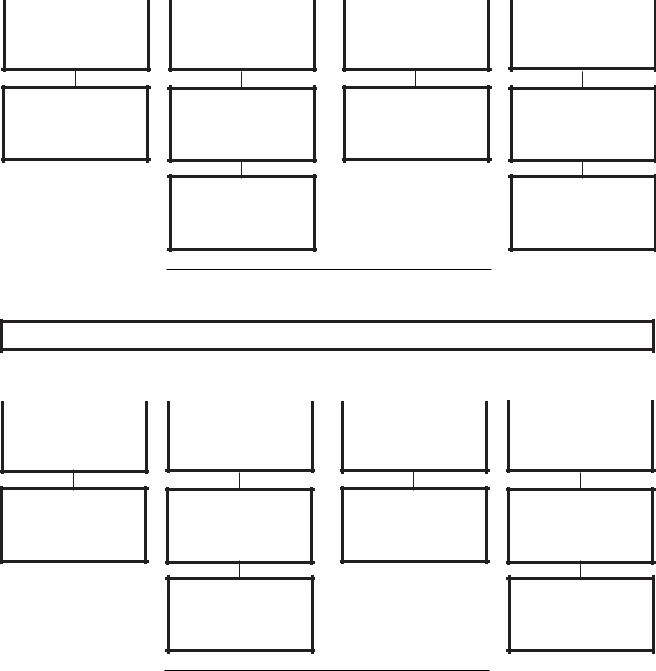
|
|
|
|
|
|
|
|
15 |
|||||
3.5 VENTING APPLICATION FLOW CHART |
|
|
|
|
|
|
|||||||
|
|
|
|
|
|
||||||||
|
|
|
|
|
|
|
|
|
|
|
|
|
|
|
|
|
|
|
TOP EXIT |
|
|
|
|
|
EN |
||
|
|
|
|
|
|
|
|
|
|
|
|
|
|
|
Horizontal Termination |
|
|
Vertical Termination |
|
|
|||||||
|
|
|
|
|
|
|
|
|
|
|
|
|
|
Vertical rise is equal to or greater than the horizontal run
Horizontal run + vertical rise to maximum of 35 feet (10.7m)
Vertical rise is less than horizontal run
Horizontal run + vertical rise to maximum of 24.75 feet (7.5m)
4.2 times the vertical rise equal to or greater than the horizontal run
Vertical rise is equal to or greater than the horizontal run
Horizontal run + vertical rise to maximum of 35 feet (10.7m)
Vertical rise is less than horizontal run
Horizontal run + vertical rise to maximum of 35 feet (10.7m)
3 times the vertical rise equal to or greater than the horizontal run
13.3A
REAR EXIT
Horizontal Termination |
|
|
Vertical Termination |
|||||||
|
|
|
|
|
|
|
|
|
|
|
Vertical rise is equal to or greater than the horizontal run
Horizontal run +
vertical rise to maximum of 40 feet
(12m)
Vertical rise is less than horizontal run
Horizontal run + vertical rise to maximum of 24.75 feet (7.5m)
3.5 times the vertical rise equal to or greater than the horizontal run
Vertical rise is equal to or greater than the horizontal run
Horizontal run + vertical rise to maximum of 40 feet (12m)
Vertical rise is less than horizontal run
Horizontal run + vertical rise to maximum of 40 feet (12m)
3 times the vertical rise equal to or greater than the horizontal run
13.2A
W415-1401 / C / 03.18.15

16
3.6DEFINITIONS
EN |
For the following symbols used in the venting calculations and examples are: |
|
> - greater than |
||
|
> - equal to or greater than |
|
|
< - less than |
|
|
< - equal to or less than |
|
|
||
|
HT |
- total of both horizontal vent lengths (Hr) and offsets (Ho) in feet |
|
HR |
- combined horizontal vent lengths in feet |
|
HO |
- offset factor: .03 (total degrees of offset - 90°*) in feet |
|
VT |
- combined vertical vent lengths in feet |
14.1
3.7ELBOW VENT LENGTH VALUES
|
FEET |
INCHES |
MILLIMETERS |
|
1° |
0.03 |
|
0.5 |
12.7 |
15° |
0.45 |
6.0 |
152.4 |
|
30° |
0.9 |
11.0 |
279.4 |
|
45° |
1.35 |
16.0 |
406.4 |
|
90°* |
2.7 |
32.0 |
812.8 |
|
* The first 90° offset has a zero value and is shown in the formula as - 90°
15.1A
W415-1401 / C / 03.18.15
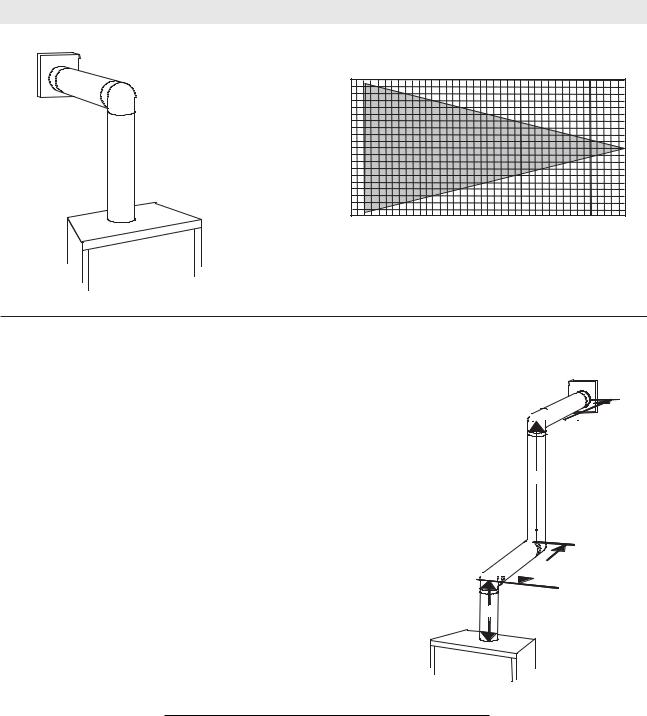
3.8TOP EXIT HORIZONTAL TERMINATION
(HT) < (VT)
Simple venting configuration (only one 90° elbow)
40 (12.2)
39 (11.9) 
17
See graph to determine the required vertical |
EN |
|
|
rise VT for the required horizontal run HT. |
|
|
|
REQUIRED |
30 (9.1) |
|
|
|
|
|
|
|
|
|
|
|
|
|
|
|
|
|
|
VERTICAL |
|
|
|
|
|
|
|
|
|
RISE IN FEET 20 (6.1) |
|
|
|
|
|
|
|
|
|
(METERS)VT |
|
|
|
|
|
|
|
|
|
|
10 (3.1) |
|
|
|
|
|
|
|
|
|
0 |
2.5 |
5 |
7.5 |
10 |
12.5 |
15 |
17.5 |
20 |
|
|
(0.8) |
(1.5) |
(2.3) |
(3.1) |
(3.8) |
(4.6) |
(5.3) |
(6.1) |
HORIZONTAL VENT RUN PLUS OFFSET IN
FEET (METERS) HT
The shaded area within the lines represents acceptable values for HT and VT
For vent configurations requiring more than one 90° elbow, the following formulas apply:
Formula 1: HT < VT
Formula 2: HT + VT < 40 feet (12.2m)
Example:
V1 |
= 3 FT (0.9m) |
V2 |
= 8 FT (2.4m) |
VT |
= V1 + V2= 3 FT (0.9m ) + 8 FT (2.4m) = 11 FT (3.4m) |
H1 |
= 2.5 FT (0.8m) |
H2 |
= 2 FT (0.6m) |
HR |
= H1 + H2 = 2.5 FT (0.8m) + 2 FT (0.6m) = 4.5 FT (1.4m) |
HO = .03 (three 90° elbows - 90°) = .03 (270° - 90°) = 5.4 FT (1.7m) HT = HR + HO = 4.5 FT (1.4m) + 5.4 FT (1.6m) = 9.9 FT (3m) HT + VT = 9.9 FT (3m) + 11 FT (3.4m) = 20.9 FT (6.4m)
Formula 1: HT < VT
9.9 FT (3m) < 11 FT (3.4m)
Formula 2: HT + VT < 40 FT (12.2m)
20.9 FT (6.4m) < 40 FT (12.2m)
Since both formulas are met, this vent configuration is acceptable.
90°



 H2
H2
V2
90°


90°




 H1
H1
V1
16.1B
W415-1401 / C / 03.18.15
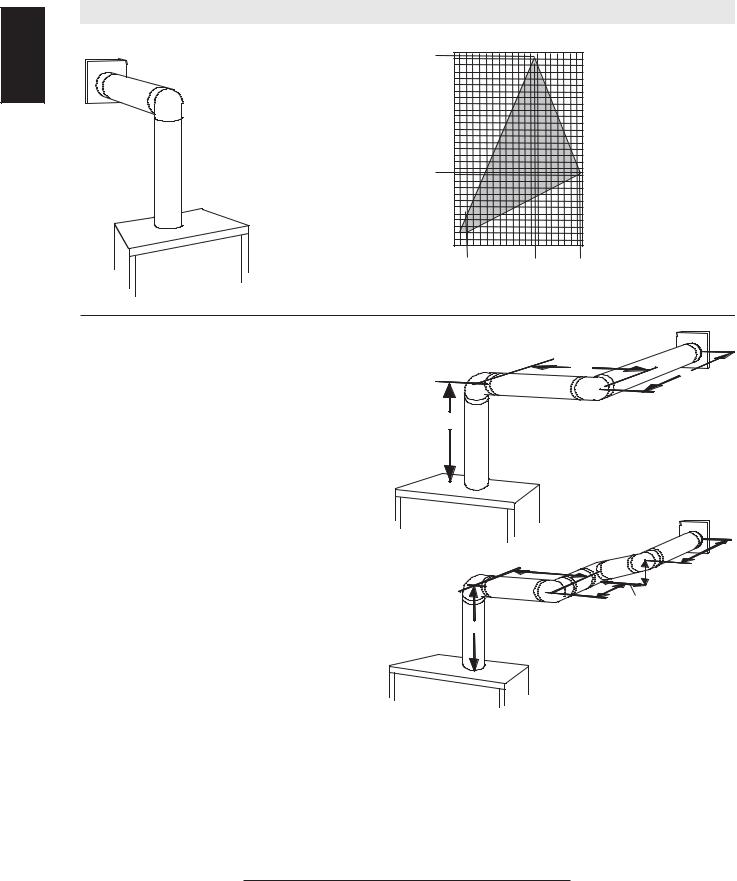
18
Simple venting configuration |
(HT) > (VT) |
||
See graph to determine the required vertical rise VT for the required horizontal run HT. |
|||
(only one 90° elbow) |
|
150 |
(3810) |
EN |
|
147 (3733.8) |
|
|
REQUIRED |
|
|
|
VERTICAL |
100 |
(2540) |
|
RISE IN INCHES |
|
|
|
(MILLIMETERS) VT |
|
|
|
|
57 (1447.8) |
|
|
|
50 |
(1270) |
10 (254)
0 |
5 |
10 |
|
15 |
20 (6.1) |
2 |
(1.5) |
(3.1) |
12.5 |
(4.6) |
19.5 |
(0.6) |
|
|
(3.8) |
|
(5.9) |
HORIZONTAL VENT RUN PLUS OFFSET IN FEET (METERS) HT
The shaded area within the lines represents acceptable values for HT and VT
For vent configurations requiring more than one 90° elbow, the following formulas apply:
Formula 1: HT |
< 4.2 VT |
90° |
|
|
H1 |
|
||||||
Formula 2: HT |
+ VT < 24.75 feet (7.5m) |
|
|
H2 |
||||||||
Example: |
|
|
|
|
|
|
|
|
||||
|
|
|
|
|
|
|
|
|
||||
V1 |
= VT = 6 FT (1.8m) |
|
V1 |
|
|
90° |
|
|||||
H1 |
= 3 FT (0.9m) |
|
|
|
|
|
||||||
H2 |
= 5 FT (1.5m) |
|
|
|
|
|
|
|||||
HR |
= H1 |
+ H2 |
= 3FT (0.9m) + 5FT (1.5m) = 8FT (2.4m) |
|
|
|
|
|
||||
HO |
= .03 (two 90° elbows - 90°) = .03 (180° - 90°) = 2.7FT (0.8m) |
|
|
|
|
|
||||||
HT |
= HR |
+ HO |
= 8FT (2.4m) + 2.7FT (0.8m) = 10.7FT (3.3m) |
|
|
|
|
|
||||
HT |
+ VT |
= 10.7FT (3.3m) + 6FT (1.8m) = 16.7FT (5.1m) |
|
|
|
|
|
|||||
Formula 1: |
|
HT |
< 4.2 VT |
|
|
|
|
90° |
||||
Formula 2: |
|
HT |
4.2 VT = 4.2FT (1.3m) x 6FT (1.8m) = 25.2FT (7.7m) |
|
|
|
||||||
|
+ VT < 24.75 FT (7.5m) |
|
H |
|
90° |
H4 |
||||||
|
|
|
|
|
|
16.7 FT (5.1m) < 24.75 FT (7.5m) |
90° |
1 |
||||
Since both formulas are met, this vent configuration is acceptable. |
|
|
V2 |
|||||||||
|
|
|
H2 |
|||||||||
Example: |
|
|
|
|
|
90° |
H3 |
|||||
V |
|
= 4 FT (1.2m) |
|
|
|
|
||||||
V21 |
= 1.5 FT (0.5m) |
|
V1 |
|
|
|
|
|||||
V |
T |
= V + V |
2 |
= 4 FT (1.2m) + 1.5 FT (0.5m) = 5.5 FT (1.7m) |
|
|
|
|
|
|||
|
1 |
|
|
|
|
|
|
|
|
|
||
H1 |
= 2 FT (0.6m) |
|
|
|
|
|
|
|||||
H2 |
= 1 FT (0.3m) |
|
|
|
|
|
|
|||||
H3 |
= 1 FT (0.3m) |
|
|
|
|
|
|
|||||
H4 |
= 1.5 FT (0.5m) |
|
|
|
|
|
|
|||||
HR |
= H1 |
+ H2 |
+ H3 + H4 = 2FT (0.6m) + 1FT (0.3m) + 1FT (0.3m) + 1.5FT (0.5m) = 5.5 FT (1.7m) |
|
||||||||
HO |
= .03 (four 90° elbows - 90°) = .03 (360° - 90°) = 8.1 FT (2.5m) |
|
|
|
|
|
||||||
HT |
= HR |
+ HO |
= 5.5 FT (1.7m) + 8.1 FT (2.5m) = 13.6 FT (4.2m) |
|
|
|
|
|
||||
HT |
+ VT |
= 13.6 FT (4.2m) + 5.5 FT (1.7m) = 19.1 FT (5.8m) |
|
|
|
|
|
|||||
Formula 1: |
|
HT |
< 4.2 VT |
|
|
|
|
|
||||
|
|
|
|
|
|
|
4.2 VT = 4.2 FT (1.3m) x 5.5 FT (1.7m) = 23.1 FT (7m) |
|
|
|
|
|
|
|
|
|
|
|
13.6 FT (4.2m) < 23.1 FT (7m) |
|
|
|
|
|
|
Formula 2: |
|
HT |
+ VT < 24.75 FT (7.5m) |
|
|
|
|
|
||||
19.1 FT (5.8m) < 24.75 FT (7.5m)
Since both formulas are met, this vent configuration is acceptable.
16.2_3B
W415-1401 / C / 03.18.15

19
3.9REAR EXIT HORIZONTAL TERMINATION
|
(HT) < (VT) |
|
|
|
|
|
|
|
EN |
|
Simple venting configuration |
|
|
|
|
|
|
|
|
|
|
See graph to determine the required vertical rise VT for the required |
||||||||||
(only two 90° elbows) |
|
|
horizontal run HT. |
|
|
|
|
|||
|
|
40 (12.2) |
|
|
|
|
|
|
|
|
|
38.3 (11.7) |
|
|
|
|
|
|
|
|
|
|
REQUIRED |
30 (9.1) |
|
|
|
|
|
|
|
|
|
|
|
|
|
|
|
|
|
|
|
|
VERTICAL |
|
|
|
|
|
|
|
|
|
|
RISE IN |
20 (6.1) |
|
|
|
|
|
|
|
|
|
FEET |
|
|
|
|
|
|
|
|
|
|
(METERS) VT |
10 (3.1) |
|
|
|
|
|
|
|
|
|
1.6 (0.5) |
|
|
|
|
|
|
|
|
|
|
|
0 |
2.5 |
5 |
7.5 |
10 |
12.5 |
15 |
17.5 |
20 |
|
|
1.6 |
(0.8) |
(1.5) |
(2.3) |
(3.1) |
(3.8) |
(4.6) |
(5.3) |
(6.1) |
|
|
(0.5) |
|
|
|
|
|
|
|
|
HORIZONTAL VENT RUN PLUS OFFSET IN FEET (METERS) HT
The shaded area within the lines represents acceptable values for HT and HT
For vent configurations requiring more than two 90° elbows, the following formulas apply:
Formula 1: HT |
< VT |
90° |
|
|
|||||||||||||
Formula 2: HT |
+ VT < 40 feet (12.2m) |
|
|
|
|
|
|
|
|
H3 |
|||||||
|
|
|
|
|
|
|
|
||||||||||
Example: |
|
|
|
|
|
|
|
|
|
|
|
|
|
|
|||
|
|
|
|
|
|
|
|
|
|
|
|
|
|
|
|||
V |
= 9 FT (2.7m) |
|
|
|
|
|
|
|
|
|
|||||||
V21 |
= 6 FT (1.8m) |
90° |
V2 |
||||||||||||||
VT |
= V1 |
+ V2 = 9FT (2.7m) + 6FT (1.8m) = 15FT (4.6m) |
|
|
|
|
|
||||||||||
H1 |
= 3 FT (0.9m) |
|
|
|
|
|
H2 |
||||||||||
|
|
|
|
||||||||||||||
H2 |
= 2 FT (0.6m) |
|
|
|
|
|
|
|
|
|
|||||||
H3 |
= 1.5 FT (0.5m) |
|
|
|
|
|
|
|
|
90° |
|||||||
HR |
= H1 |
+ H2 + H3 = 3FT (0.9m) + 2FT (0.6m) + 1.5FT (0.5m) = 6.5FT (2m) |
|
|
|
|
|
|
|||||||||
HO |
= .03 (four 90° elbows - 90°) = .03 (360° - 90°) = 8.1 FT (2.5m) |
|
|
|
|
V1 |
|
|
|
|
|
||||||
|
|
|
|||||||||||||||
|
|
|
|
||||||||||||||
HT |
= HR |
+ HO = 6.5FT (2m) + 8.1FT (2.5m) = 14.6FT (4.5m) |
|
|
|
|
|
|
|
|
|
|
|
|
|
||
HT |
+ VT |
= 14.6FT (4.5m) + 15FT (4.6m) = 29.6 FT (9m) |
|
|
|
|
H1 |
|
|
|
|
|
|
|
|
||
|
|
|
|
|
|
|
|
|
|
|
|
||||||
Formula 1: |
HT < VT |
|
|
|
|
|
|
|
|
|
|||||||
|
|
|
|
|
|
|
|
90° |
|
|
|||||||
|
|
|
14.6 FT (4.5m) < 15 FT (4.6m) |
|
|
|
|
|
|
|
|
|
|
||||
|
|
|
|
|
|
|
|
|
|
|
|
|
|
|
|
||
Formula 2: |
HT + VT < 40 FT (12.2m) |
|
|
|
|
|
|
|
|
|
|
|
|
|
|||
|
|
|
29.6 FT (9m) < 40 FT (12.2m) |
|
|
|
|
|
|
|
|
|
|
|
|
|
|
Since both formulas are met, this vent configuration is acceptable. |
|
|
|
|
|
|
|
|
|
|
|
|
|
||||
|
|
|
|
|
|
16.3A |
|||||||||||
|
|
|
|
|
|
|
|
|
|
|
|||||||
|
|
|
|
|
|
|
|
|
|
|
|||||||
|
|
|
|
|
|
|
|
|
|
|
|||||||
|
|
|
|
|
|
|
|
|
|
|
|||||||
W415-1401 / C / 03.18.15
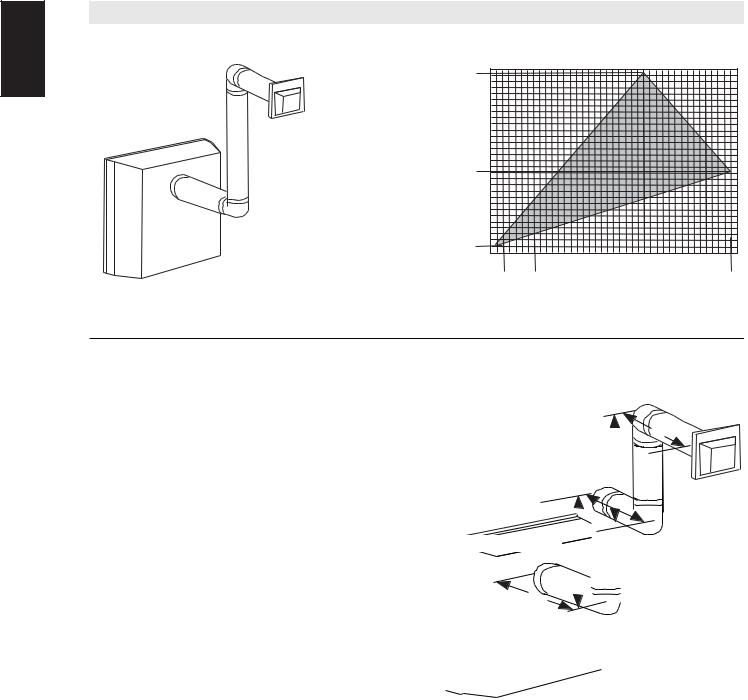
20
EN
(HT) > (VT)
Simple venting configuration (only two 90° elbows)
See graph to determine the required vertical rise VT for the required horizontal run HT.
|
150(3810) |
|
|
|
|
|
|
|
|
|
|
|
|
|
150(3810) |
|
|
|
|
|
|
|
|
|
|
|
|
147 (3733.8 |
|
|
|
|
|
|
|
|
|
|
|
|
|
|
147 (3733.8 |
|
|
|
|
|
|
|
|
|
|
|
|
REQUIRED |
|
|
|
|
|
|
|
|
|
|
|
|
|
VERTICAL RISE IN |
100 (2540) |
|
|
|
|
|
|
|
|
|
|
|
|
100 (2540) |
|
|
|
|
|
|
|
|
|
|
|
||
INCHES |
|
|
|
|
|
|
|
|
|
|
|
|
|
(MILLIMETERS)VT |
6666 |
|
|
|
|
|
|
|
|
|
|
|
|
|
|
|
|
|
|
|
|
|
|
|
|
|
|
|
(1676.4) |
|
|
|
|
|
|
|
|
|
|
|
|
|
(1676.4) |
|
|
|
|
|
|
|
|
|
|
|
|
|
50 (1270) |
|
|
|
|
|
|
|
|
|
|
|
|
|
50 (1270) |
|
|
|
|
|
|
|
|
|
|
|
|
|
12 |
|
|
|
|
|
|
|
|
|
|
|
|
|
(304.8) |
|
|
|
|
|
|
|
|
|
|
|
|
|
8 (203) |
|
|
|
|
|
|
|
|
|
|
|
|
|
0 |
0 |
|
|
2.5 |
5 |
5 |
7.5 |
10 |
12.5 |
15 |
17.5 |
20 |
|
|
|
|
2.5 |
|
7.5 |
10 |
12.5 |
15 |
17.5 |
20 |
||
|
|
|
|
(0.8) |
(1.5) |
(2.3) |
(3.1) |
(3.8) |
(4.6) |
(5.3) |
(6.1) |
||
|
|
|
|
|
(0.8) |
(1.5) |
(2.3) |
(3.1) |
(3.8) |
(4.6) |
(5.3) |
(6.1) |
|
|
|
|
1 |
1 |
3.5 |
|
|
|
|
|
|
|
19.25 |
|
|
|
|
3.5 |
|
|
|
|
|
|
|
19.25 |
|
|
|
|
(0.3) |
(1.1) |
|
|
|
|
|
|
|
(5.9) |
|
|
|
|
(0.3) |
(1.1) |
|
|
|
|
|
|
|
(5.9) |
|
HORIZONTAL VENT RUN PLUS OFFSET IN FEET (METERS) HT The shaded area within the lines represents acceptable
values for HT and HT
For vent configurations requiring more than two 90° elbows, the following formulas apply:
Formula 1: HT |
< 3.5VT |
|
|
|
|
|
|
|
|
|
|||||||||||
Formula 2: HT |
+ VT < 24.75 feet (7.5m) |
|
90° |
|
|
||||||||||||||||
Example: |
|
|
|
|
|
|
|
|
|
|
|
|
|
|
|
|
|
|
H3 |
||
|
|
|
|
|
|
|
|
|
|
|
|
|
|
|
|
|
|
||||
V1 |
= 4 FT (1.2m) |
|
|
|
|
|
|
|
|
|
|||||||||||
|
|
|
|
|
|
|
|
|
|||||||||||||
V |
= 1.5 FT (0.5m) |
|
|
|
|
|
|
|
|
|
|||||||||||
V2 |
= V + V |
|
= 4FT (1.2m) + 1.5FT (0.5m) = 5.5 FT (1.7m) |
|
|
|
|
V2 |
|||||||||||||
T |
1 |
|
2 |
|
|
|
|
|
|
|
|
|
|
90° |
|
|
|
|
|
||
H1 |
= 2 FT (0.6m) |
|
|
|
|
|
|
||||||||||||||
H2 |
= 1 FT (0.3m) |
|
|
|
|
|
H2 |
||||||||||||||
H3 |
= 1 FT (0.3m) |
|
|
|
|
|
|
|
|
|
|||||||||||
H4 |
= 1.5 FT (0.5m) |
|
|
|
|
|
|
|
|
|
|
||||||||||
HR |
= H1+ H2+H3+H4= 2FT(0.6m) + 1FT(0.3m) + 1FT(0.3m) + 1.5FT(0.5m) = 5.5 FT(1.7m) |
|
|
|
|
90° |
|||||||||||||||
V1 |
|
|
|
||||||||||||||||||
HO |
= .03 (four 90° elbows + one 45° elbow - 90°) |
|
|
|
|
|
|
|
|
|
|
|
|||||||||
|
|
|
|
|
|
||||||||||||||||
|
|
|
|
|
|
||||||||||||||||
|
= .03 (90 + 90 + 90 + 90 + 45 - 90) = 9.45 FT (2.9m) |
|
|
|
|
|
|
|
|
|
|
|
|
|
|
||||||
HT |
= HR |
+ HO = 5.5FT (1.7m) + 9.45FT (2.9m) = 14.95FT (4.6m) |
|
|
|
|
|
H1 |
|
|
|
|
|
|
|
|
|||||
|
|
|
|
|
|
|
|
|
|
|
|
|
|||||||||
HT |
+ VT |
= 14.95FT (4.6m) + 5.5FT (1.7m) = 20.45FT (6.2m) |
|
|
|
|
|
|
|
|
|
|
|
|
|
||||||
|
|
|
|
|
|
|
|
|
|
|
|
|
|||||||||
Formula 1: |
|
HT < 3.5VT |
|
|
|
|
|
|
|
|
|
|
|
|
|
|
|||||
|
|
|
|
|
|
|
|
|
|
|
90° |
|
|
||||||||
|
|
|
|
|
|
|
|
|
|
|
|
|
|
|
|
||||||
|
|
|
|
|
3.5VT = 3.5FT (1.1m) x 5.5FT (1.7m) = 19.25FT (5.9m) |
|
|
|
|
|
|
|
|
|
|||||||
|
|
|
|
|
14.95 FT (4.6m) < 19.25 FT (5.9m) |
|
|
|
|
|
|
|
|
|
|
|
|
|
|
||
|
|
|
|
|
|
|
|
|
|
|
|
|
|
|
|
|
|
|
|||
Formula 2: |
|
HT + VT < 24.75 FT (7.5m) |
|
|
|
|
|
|
|
|
|
|
|
|
|
|
|||||
|
|
|
|
|
|
|
|
|
|
|
|
|
|
|
|||||||
|
|
|
|
|
20.45 FT (6.2m) < 24.75 FT (7.5m) |
|
|
|
|
|
|
|
|
|
|
|
|
|
|
||
Since both formulas are met, this vent configuration is acceptable. |
|
|
|
|
16.3_2B |
||||||||||||||||
|
|
|
|||||||||||||||||||
|
|
|
|
|
|
|
|
|
|
|
|
|
|
|
|||||||
|
|
|
|
|
|
|
|
|
|
|
|
|
|
|
|||||||
W415-1401 / C / 03.18.15

|
|
21 |
||
3.10 TOP OR REAR EXIT VERTICAL TERMINATION |
|
|||
|
||||
|
|
|
|
|
|
|
(HT) < (VT) |
EN |
|
|
Simple venting configurations. |
See graph to determine the required vertical rise VT for the |
||
|
|
|||
|
|
required horizontal run HT. |
|
|
|
40 (12.2) |
|
|
|
|
|
30 (9.1) |
|
|
|
|
REQUIRED |
|
|
|
|
|
VERTICAL RISE |
|
|
|
|
|
IN FEET |
20 (6.1) |
|
|
|
|
(METERS)VT |
|
|
|
|
|
|
10 (3.1) |
|
|
|
|
|
3 (0.9) |
|
|
|
|
|
0 |
5 |
10 |
15 |
20 |
|
|
(1.5) |
(3.1) |
(4.6) |
(6.1) |
HORIZONTAL VENT RUN PLUS OFFSET IN FEET
(METERS) HT
The shaded area within the lines represents acceptable values for HT and HT
For vent configurations requiring one or more 90° elbows (top exit) or one or more 90° elbows (rear exit), the following formulas apply:
Formula 1: HT |
< VT |
|||||||||
Formula 2: HT |
+ VT < 40 feet (12.2m) |
|||||||||
Example: |
|
|
|
|
|
|
||||
V1 |
= 5 FT (1.5m) |
|
|
|
|
|||||
V2 |
= 6 FT (1.8m) |
|
|
|
|
|||||
V3 |
= 10 FT (3.1m) |
|||||||||
V |
T |
= V |
1 |
+ V + V |
3 |
= 5FT (1.5m) + 6FT (1.8m) + 10FT (3.1m) = 21 FT (6.4m) |
||||
|
|
2 |
|
|
|
|
|
|||
H1 |
= 8 FT (2.4m) |
|
|
|
|
|||||
H2 |
= 2.5 FT (0.8m) |
|||||||||
HR |
= H1+ H2 = 8FT (2.4m) + 2.5FT (0.8m) = 10.5FT (3.2m) |
|||||||||
HO |
= .03 (four 90° elbows - 90°) |
|
|
|
||||||
|
|
= .03 (360° - 90°) = 8.1 FT (2.5m) |
|
|
|
|||||
HT |
= HR |
+ HO = 10.5FT (3.2m) + 8.1FT (2.5m) = 18.6FT (5.7m) |
|
|
|
|||||
HT |
+ VT |
= 18.6FT (5.7m) + 21FT (6.4m) = 39.6FT (12.1m) |
|
|
|
|||||
Formula 1: |
|
|
HT < 3.5VT |
|
|
|
||||
|
|
|
|
|
|
|
18.6 FT (5.7m) < 21 FT (6.4m) |
|
|
|
Formula 2: |
|
|
HT + VT < 40 FT (12.2m) |
|
|
|
||||
|
|
|
|
|
|
|
39.6FT (12.1m) < 40 FT (12.2m) |
|
|
|
Since both formulas are met, this vent configuration is acceptable. |
|
|
|
|||||||
|
|
|
|
|
|
|
|
|
|
|
18.2A
W415-1401 / C / 03.18.15
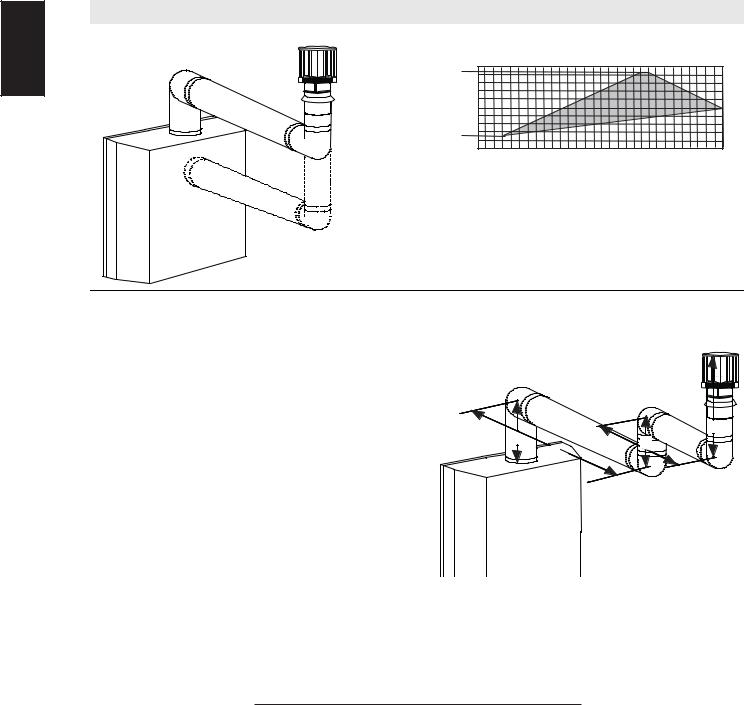
22
(HT) > (VT)
Simple venting configurations. |
See graph to determine the required vertical rise VT for the |
EN |
required horizontal run HT. |
|
20 (6.1) |
|
|
|
|
|
|
|
19 (5.8) |
|
|
|
|
|
|
REQUIRED |
|
|
|
|
|
|
|
VERTICAL |
10 (3.1) |
|
|
|
|
|
|
RISE IN |
|
|
|
|
|
|
|
|
|
|
|
|
|
|
|
FEET |
3 (0.9) |
|
|
|
|
|
|
(METERS)V |
|
|
|
|
|
|
|
|
T |
|
|
|
|
|
|
|
0 |
5 |
10 |
15 |
20 |
25 |
30 |
|
|
(1.5) |
(3.1) |
(4.6) |
(6.1) |
(7.6) |
(9.1) |
HORIZONTAL VENT RUN PLUS OFFSET IN FEET (METERS)HT
The shaded area within the lines represents acceptable values for HT and HT
For vent configurations requiring more than two 90° elbows (top exit) or one 90° elbow (rear exit), the following formulas apply:
Formula 1: HT < 3 VT
Formula 2: HT + VT < 40 feet (12.2m)
Example: |
|
|
90° |
|
|
|
|
|
|||
V1 |
= 2 FT (0.6m) |
|
|
|
|
90° |
|
||||
V2 |
= 1 FT (0.3m) |
|
|
|
|
|
|
V3 |
|||
V |
= 1.5 FT (0.5m) |
V1 |
|
|
|
|
|||||
V3 |
= V + V + V = 2FT (0.6m) + 1FT (0.3m) + 1.5FT (0.5m) = 4.5 FT (1.4m) |
H |
|
V |
|
|
|||||
T |
1 |
|
2 |
3 |
|
|
H1 |
2 |
|
2 |
|
H1 |
= 6 FT (1.8m) |
|
|
|
|
|
|
|
|||
H2 |
= 2 FT (0.6m) |
|
|
|
|
90° |
90° |
||||
HR |
= H1 |
+ H2 |
= 6FT (1.8m) + 2FT (0.6m) = 8 FT (2.4m) |
|
|
|
|
||||
HO |
= .03 (four 90° elbows - 90°) |
|
|
|
|
|
|
||||
|
= .03 (360° - 90°) = 8.1 FT (2.5m) |
|
|
|
|
|
|
||||
HT |
= HR |
+ HO |
= 8FT (2.4m) + 8.1FT (2.5m) = 16.1FT (4.9m) |
|
|
|
|
|
|
||
HT |
+ VT |
= 16.1FT (4.9m) + 4.5FT (1.4m) = 20.6FT (6.3m) |
|
|
|
|
|
|
|||
Formula 1: |
H |
< 3.5 V |
|
T |
3.5 V T = 3FT (0.9m) x 4.5FT (1.4m) = 13.5 FT (4.1m) |
|
|
T |
|
16.1FT (4.9m) < 13.5 FT (4.1m) |
|
Since this formula is not met, this vent configuration is unacceptable. |
||
Formula 2: |
HT |
+ VT < 40 FT (12.2m) |
|
16.1FT (4.9m) < 13.5 (4.1m) |
|
Since only formula 2 is met, this vent configuration is unacceptable and a new fireplace location or vent configuration will need to be established to satisfy both formulas.
18.2_2B
W415-1401 / C / 03.18.15
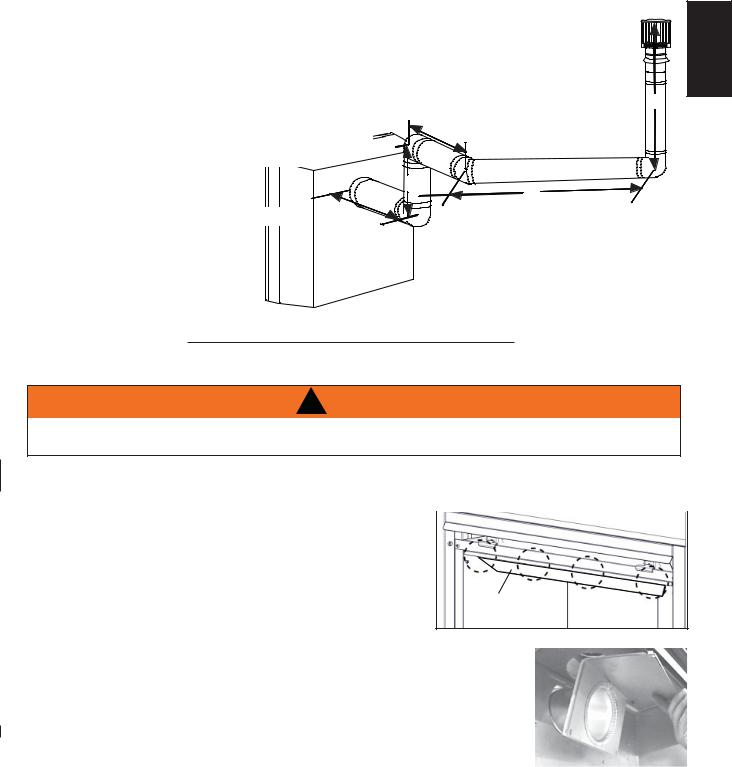
Example: |
|
|
||||
V1 |
= 1.5 FT (0.5m) |
|
|
|||
V2 |
= 5 FT (1.5m) |
|
|
|||
V |
T |
= V |
1 |
+ V = 1.5FT (0.5m)+ 5FT (1.5m) = 6.5 FT (2m) |
|
|
|
|
2 |
|
|
||
H1 |
= 1 FT (0.3m) |
|
|
|||
H2 |
= 1 FT (0.3m) |
|
|
|||
H3 |
= 10.75 FT (3.3m) |
|
|
|||
HR |
= H1 |
+ H2 + H3 = 1FT (0.3m) + 1FT (0.3m) + 10.75FT (3.3m) = 12.75FT (3.9m) |
||||
HO |
= .03 (four 90° elbows + one 45° elbow - 90°) |
|
90° |
|||
HT |
= .03 (360° + 45° - 90°) = 6.75 FT (2.1m) |
|
H2 |
|||
= HR |
+ HO = 12.75FT (3.9m) + 6.75FT (2.1m) = 19.5 FT (5.9m) |
45° |
||||
HT |
+ VT |
= 19.5FT (5.9m) + 6.5FT (2m) = 26 FT (7.9m) |
|
|
||
Formula 1: |
|
V1 |
||||
HT |
< 3 VT |
H1 |
|
|||
|
|
3 V = 3FT (0.9m) x 6.5FT (2m) = 19.5FT (5.9m) |
|
|||
|
|
|
|
T |
|
|
19.5FT (5.9m) = 19.5FT (5.9m) |
|
90° |
||||
Formula 2: |
|
|
||||
HT |
+ VT |
< 40 FT (12.2m) |
|
|
||
26 FT (7.9m) < 40 FT (12.2m) |
|
|
||||
Since both formulas are met, this vent configuration is acceptable.
H3
18.2_3A
23
EN
V2
90°
3.11 REAR EXIT
! WARNING
FAILURE TO INSTALL THE CAP WILL CAUSE THE APPLIANCE TO FUNCTION IMPROPERLY AND
CAN CAUSE INJURY OR PROPERTY DAMAGE.
NOTE: A #42 orifice was supplied with your appliance. In installations with a vertical rise greater than 8" (203mm) in the vent configuration, the #42 orifice must be used to increase the flame size.
A. |
Remove the safety screen and glass front, refer to " |
Fig. 1 |
|
||
|
SAFETY SCREEN & DOOR REMOVAL / INSTALLATION" |
|
|
section. |
|
B. |
Remove the contents from the firebox and set aside, you |
|
|
will need the exhaust flue collar from the top of the log |
DEFLECTOR |
|
carton. |
C.To ease assembly, remove the four hex head screws
securing the deflector from inside the top front of the firebox, refer to Figure 1.
D.Place the gasket (provided) over the 4" (102mm) flue collar assembly and bend along perforation.
E.From inside the firebox, insert the 4" (102mm) flue collar through the back of the firebox. Secure the flue collar assembly and gasket using the four hex head 3/8" thread cutting screws, refer to Figure 2. NOTE: Do not overtighten. The gasket needs only to be snug against the firebox.
F.Re-attach the deflector using the four screws and install the log set, glass
door and safety screen. |
Fig. 2 |
W415-1401 / C / 03.18.15

24
3.12 TOP EXIT
|
|
|
! WARNING |
EN |
|
|
FAILURE TO INSTALL THE CAP WILL CAUSE THE APPLIANCE TO FUNCTION IMPROPERLY AND |
|
|
CAN CAUSE INJURY OR PROPERTY DAMAGE. |
|
|
|
|
|
|
|
|
|
|
|
|
NOTE: A #42 orifice was supplied with your appliance. In installations with a vertical rise greater than |
|
|
|
|
|
|
|
8" (203mm) in the vent configuration, the #42 orifice must be used to increase the flame size. |
|
|
NOTE: This appliance has been factory shipped as a rear vent. |
|
A.Remove the safety screen and glass front, refer to " SAFETY SCREEN & DOOR REMOVAL / INSTALLATION" section.
B.Remove the contents from the firebox and set aside, you will need the flue collar from the top of the log carton.
C. |
To ease assembly, remove the four hex head screws |
|
|
securing the deflector from inside the top front of the |
|
|
firebox. |
DEFLECTOR |
D.Remove the single screw from the outer cover on the back of the appliance.
E. |
Remove the four screws on the 7" (178mm) intake collar |
GASKET E |
|
|
assembly; set the intakecollar and gasket aside. Careful |
INTAKE COLLAR E |
|
|
not to damage gasket. |
||
F. |
Remove the single screw from the outer cover with |
ASSEMBLY |
|
OUTER COVER D |
|||
|
knockout intact, on the top of the appliance and set |
||
|
aside. |
|
G. Remove the inner cover plate and gasket by removing the four screws. Reinstall the inner cover plate and gasket onto the back of the appliance.
H. Take the outer cover (with knockout intact) and secure onto the back of the appliance.
I. Remove and discard the 1 1/2" thick batt of insulation.
J.Place the 7" (178mm) intake collar and gasket into the
|
top of the appliance and secure with |
|
|
|
INNER |
|
the four screws. |
|
OUTER |
G |
COVERPLATE |
K. |
Re-install the outer cover (without |
F |
|
||
COVER |
|
GASKET |
|||
|
knock out) over the 7" (178mm) |
|
|
||
|
F |
(with knockout) |
|
|
|
|
exhaust collar assembly and secure. |
|
|
|
|
L. |
From inside the firebox, install the 4" |
OUTER SHELL |
|
|
|
|
(102mm) exhaust collar up through the |
KNOCKOUT |
|
|
|
|
|
|
|
|
|
|
top of the firebox and secure with the |
|
|
|
|
|
the four hex head 3/8" thread cutting |
|
|
|
|
|
screws. NOTE: Do not overtighten. |
|
|
|
|
|
The gasket needs only to be snug against the firebox. |
|
|
|
|
M.Re-attach the top deflector, log set, glass door and safety screen.
 EXHAUST FLUE COLLAR
EXHAUST FLUE COLLAR
W415-1401 / C / 03.18.15

25
4.0 INSTALLATION
! WARNING |
EN |
ENSURE TO UNPACK ALL LOOSE MATERIALS FROM INSIDE THE FIREBOX PRIOR TO HOOKING UP
THE GAS AND ELECTRICAL SUPPLY.
IF YOUR APPLIANCE IS SUPPLIED WITH A REMOTE ENSURE THE REMOTE RECEIVER IS IN THE “OFF” POSITION PRIOR TO HOOKING UP THE GAS AND ELECTRICAL SUPPLY TO THE APPLIANCE.
FOR SAFE AND PROPER OPERATION OF THE APPLIANCE, FOLLOW THE VENTING INSTRUCTIONS
EXACTLY.
ALL INNER EXHAUST AND OUTER INTAKE VENT PIPE JOINTS MAY BE SEALED USING EITHER RED RTV HIGH TEMP SILICONE SEALANT W573-0002 (NOT SUPPLIED) OR BLACK HIGH TEMP MILL PAC W573-0007 (NOT SUPPLIED) WITH THE EXCEPTION OF THE APPLIANCE EXHAUST FLUE COLLAR WHICH MUST BE SEALED USING MILL PAC.
IF USING PIPE CLAMPS TO CONNECT VENT COMPONENTS, 3 SCREWS MUST ALSO BE USED TO
ENSURE THE CONNECTION CANNOT SLIP OFF.
DO NOT CLAMP THE FLEXIBLE VENT PIPE.
RISK OF FIRE, EXPLOSION OR ASPHYXIATION. IMPROPER SUPPORT OF THE ENTIRE VENTING SYSTEM MAY ALLOW VENT TO SAG AND SEPARATE. USE VENT RUN SUPPORTS AND CONNECT VENT SECTIONS PER INSTALLATION INSTRUCTIONS.
RISK OF FIRE, DO NOT ALLOW LOOSE MATERIALS OR INSULATION TO TOUCH THE VENT PIPE. REMOVE INSULATION TO ALLOW FOR THE INSTALLATION OF THE ATTIC SHIELD AND TO MAINTAIN CLEARANCES TO COMBUSTIBLES.
68.2B
4.1WALL AND CEILING PROTECTION
! WARNING
DO NOT FILL THE SPACE BETWEEN THE VENT PIPE AND ENCLOSURE WITH ANY TYPE OF MATERIAL. DO NOT PACK INSULATION OR COMBUSTIBLES BETWEEN CEILING FIRESTOPS. ALWAYS MAINTAIN SPECIFIED CLEARANCES AROUND VENTING AND FIRESTOP SYSTEMS. INSTALL WALL SHIELDS AND FIRESTOPS AS SPECIFIED. FAILURE TO KEEP INSULATION OR OTHER MATERIALS AWAY FROM VENT PIPE MAY CAUSE FIRE.
70.1
For clearances to combustible materials from the vent pipe, see “FRAMING” section.
W415-1401 / C / 03.18.15
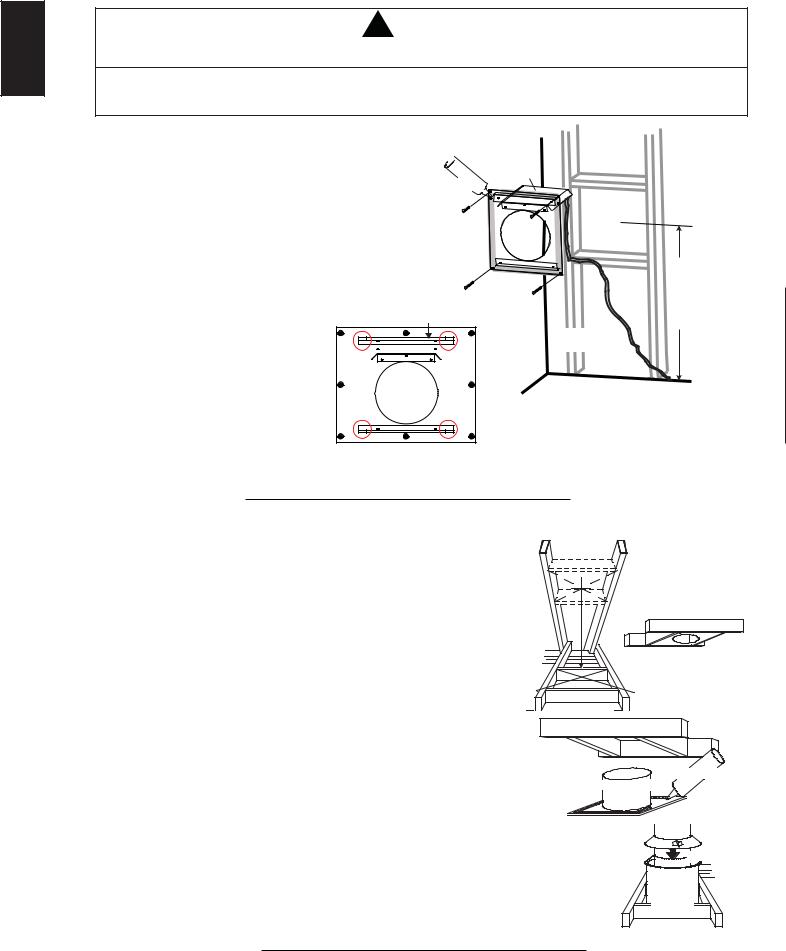
26
4.1.1 HORIZONTAL INSTALLATION
EN |
! WARNING |
THE FIRESTOP ASSEMBLY MUST BE INSTALLED WITH THE VENT SHIELD TO THE TOP. |
TERMINALS MUST NOT BE RECESSED INTO A WALL OR SIDING MORE THAN THE DEPTH OF THE
RETURN FLANGE OF THE MOUNTING PLATE.
This application occurs when venting through an exterior wall. Having determined the correct height for the air terminal location, cut and frame a hole in the exterior wall as 

illustrated to accommodate the firestop assembly. Dry
fit the firestop assembly before proceeding to ensure CAULKING  the brackets on the rear surface fit to the inside
the brackets on the rear surface fit to the inside 
surface of the horizontal framing.
The vent shield must be installed to the full depth of |
FIRESTOP |
|
SPACER |
||
the combustible wall. The length of the vent shield |
||
|
||
may be cut shorter for combustible walls that are less |
|
than 6" (152mm) thick. NOTE: Bend the tabs for reduced side clearances or move the shield for reduced top clearances.
A. Apply a bead of caulking (not supplied) around the corner edge of the inside surface of the firestop assembly, fit the firestop assembly to the hole and secure using the 4 screws (supplied in your manual baggie).
VENT
SHIELD 
FINISHING
MATERIAL
DETERMINE THE CORRECT HEIGHT
B. Once the vent pipe is installed in its final position, apply high temperature sealant W573-0007 (not supplied) between the pipe and the firestop.
20.7A
4.1.2 VERTICAL INSTALLATION
This application occurs when venting through a roof. Installation kits for various roof pitches are available from your authorized dealer / distributor. See accessories to order specific kits required.
A. Determine the air terminal location, cut and frame a square opening as |
|
|
illustrated in the ceiling and the roof to provide the minimum 1" (25mm) |
|
|
clearance between the vent pipe and any combustible material. Try to center |
|
|
the vent pipe location midway between two joists to prevent having to cut |
FIRESTOP |
|
them. Use a plumb bob to line up the center of the openings. A vent pipe |
||
UNDERSIDE OF |
||
shield will prevent any materials such as insulation, from filling up the 1" |
||
JOIST |
||
(25mm) air space around the pipe. Nail headers between the joist for |
||
|
||
extra support. |
|
B. Apply a bead of caulking (not supplied) to the framework or to the Wolf |
|
|
|
Steel vent pipe shield plate or equivalent (in the case of a finished ceiling), |
|
|
CAULKING |
and secure over the opening in the ceiling. A firestop must be placed on the |
VENT PIPE |
||
bottom of each framed opening in a roof or ceiling that the venting system passes |
|
||
SHIELD |
|
|
|
through. Apply a bead of caulking all around and place a firestop spacer over |
|
|
|
|
|
VENT |
|
the vent shield to restrict cold air from being drawn into the room or around the |
|
|
|
fireplace. Ensure that both spacer and shield maintain the required clearance to |
|
|
PIPE |
combustibles. Once the vent pipe is installed in its final position, apply sealant between the |
|
COLLAR |
|
pipe and the firestop assembly. |
|
VENT |
|
C. In the attic, slide the vent pipe collar down to cover up the open end of the shield and |
|
PIPE |
|
|
SHIELD |
||
tighten. This will prevent any materials, such as insulation, from filling up the 1" (25mm) air |
|
|
|
space around the pipe. |
|
|
|
21.1
W415-1401 / C / 03.18.15
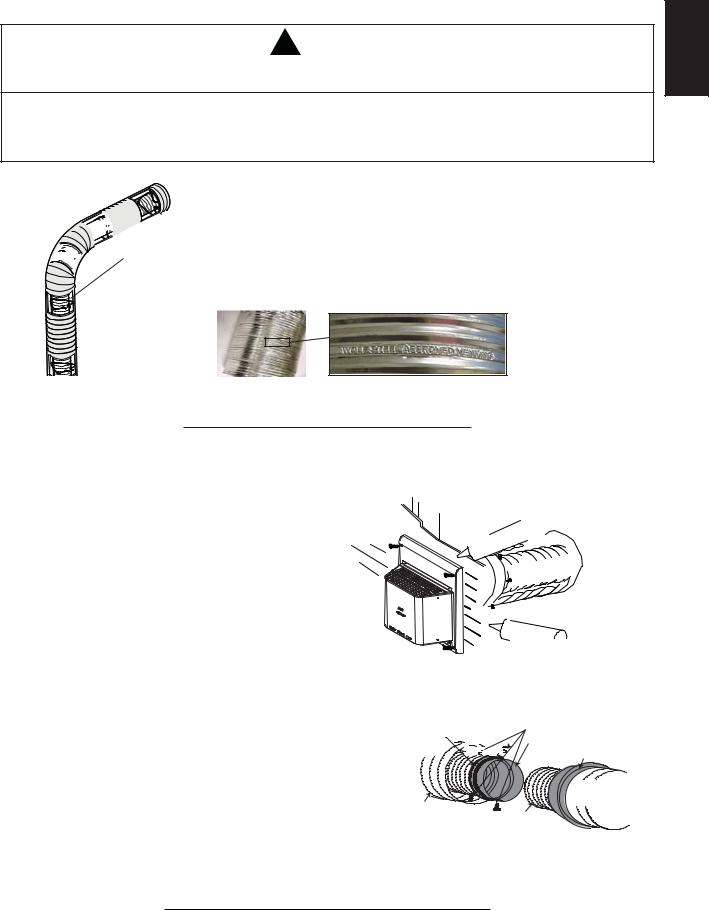
27
4.2USING FLEXIBLE VENT COMPONENTS
! WARNING |
EN |
DO NOT ALLOW THE INNER FLEX PIPE TO BUNCH UP ON HORIZONTAL OR VERTICAL RUNS AND ELBOWS.
KEEP IT PULLED TIGHT.
SPACERS ARE ATTACHED TO THE INNER FLEX PIPE AT PREDETERMINED INTERVALS TO MAINTAIN AN EVEN AIR GAP TO THE OUTER FLEX PIPE. THIS GAP IS REQUIRED FOR SAFE OPERATION. A SPACER IS REQUIRED AT THE START, MIDDLE AND END OF EACH ELBOW TO ENSURE THIS GAP IS MAINTAINED. THESE SPACERS MUST NOT BE REMOVED.
ELBOW 






 SPACERS
SPACERS
For safe and proper operation of the appliance, follow the venting instructions exactly.
All inner flex pipe and outer flex pipe joints may be sealed using high temperature sealant W573-0002 (not supplied) or the high temperature sealant W573-0007 Mill Pac (not supplied). However, the high temperature sealant W573-0007 Mill Pac (not supplied) must be used on the joint
connecting the inner flex pipe and the exhaust flue collar.
Use only approved flexible vent pipe kits marked:
“Wolf Steel Approved Venting” as identified by the stamp only on the outer flex pipe.
22.1
4.2.1 HORIZONTAL AIR TERMINAL INSTALLATION
A.Stretch the inner flex pipe to the required length taking into account the additional length needed for the finished wall surface. Apply a heavy bead of the high temperature sealant W573-0007 Mill Pac (not supplied) to the inner sleeve of the air terminal. Slip the vent pipe a minimum
of 2” (50.8mm) over the inner sleeve of the air terminal and secure with 3 #8 screws.
B.Using the outer flex pipe, slide over the outer combustion air sleeve of the air terminal and secure with 3 #8 screws. Seal using high temperature sealant W573-0002 (not supplied).
CAULKING 

|
INNER |
FLEX |
|
|
|
|
PIPE |
|
|
|
OUTER FLEX PIPE |
|
2" (50.8mm) OVERLAP |
|
#10x2" |
HIGH TEMPERATURE |
|
SCREWS |
SEALANT |
|
C. |
Insert the vent pipes through the firestop maintaining the required |
|
|
clearance to combustibles. Holding the air terminal (lettering in |
HI-TEMP |
|
an upright, readable position), secure to the exterior wall and |
|
|
make weather tight by sealing with caulking (not supplied). |
SEALANT |
#8 X 1/2” SELF DRILLING
SCREWS



 INNER COUPLER
INNER COUPLER 








 OUTER COUPLER
OUTER COUPLER
D. |
If more vent pipe needs to be used to reach the fireplace, couple |
|
|
them together as illustrated. The vent system must be |
OUTER |
|
supported approximately every 3 feet (0.9m) for both vertical |
|
|
FLEX PIPE |
|
|
and horizontal runs. Use noncombustible strapping to |
|
maintain the minimum clearance to combustibles.
INNER FLEX PIPE



 OUTER
OUTER 
 FLEX PIPE
FLEX PIPE
The air terminal mounting plate may be recessed into the exterior wall or siding no greater than the depth
of its return flange.
23.1B
W415-1401 / C / 03.18.15
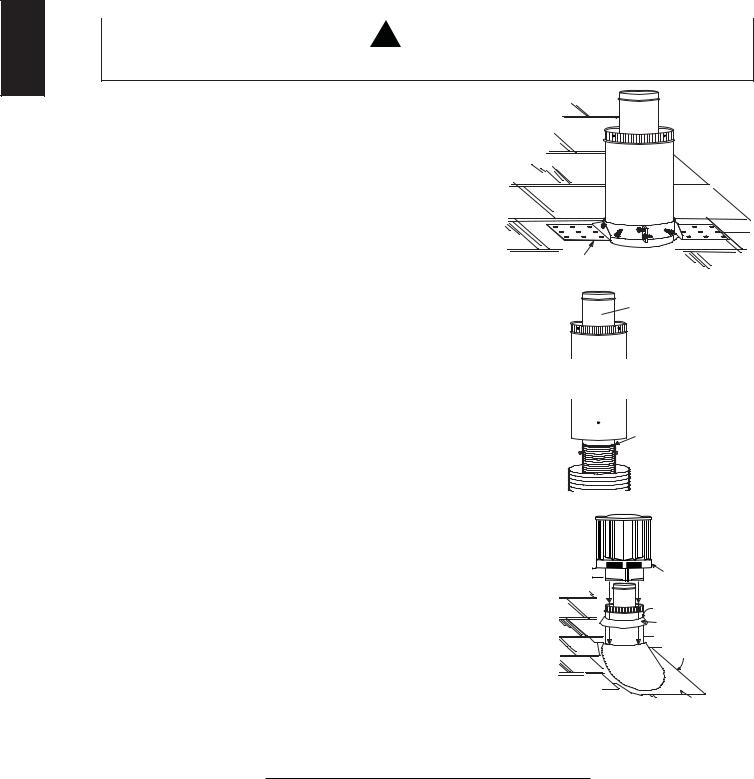
28
4.2.2 VERTICAL AIR TERMINAL INSTALLATION
EN |
! WARNING |
|
MAINTAIN A MINIMUM 2” (51mm) SPACE BETWEEN THE AIR INLET BASE AND THE STORM COLLAR.
A. Fasten the roof support to the roof using the screws provided. The roof support is optional. In this case the venting is to be adequately supported using either an alternate method suitable to the authority having jurisdiction or the optional roof support.
B. Stretch the inner flex pipe to the required length. Slip the inner flex pipe a minimum of 2” (51mm) over the inner pipe of the air terminal connector and secure with 3 #8 screws. Seal using a heavy bead of high temperature sealant W573-0007 (not supplied).
C. |
Repeat using the outer flex pipe, using a heavy bead of |
|
ROOF SUPPORT |
|
|
|
|
||
|
high temperature sealant W573-0002 (not supplied). |
|
|
|
D. |
Thread the air terminal connector / vent pipe assembly down through |
|
|
INNER PIPE |
|
|
|
||
|
the roof. The air terminal must be positioned vertically and plumb. |
|
|
|
|
Attach the air terminal connector to the roof support, ensuring that the |
AIR |
|
|
|
top of the air terminal is 16” (406mm) above the highest point that it |
|
TERMINAL |
|
|
penetrates the roof. |
CONNECTOR |
||
E. |
Remove nails from the shingles, above and to the sides of the air |
|
|
HIGH |
|
|
TEMPERATURE |
||
|
terminal connector. Place the flashing over the air terminal connector |
|
|
|
|
|
|
SEALANT |
|
|
leaving a min. 3/4” (19mm) of the air terminal connector showing |
|
|
|
|
|
|
INNER FLEX PIPE |
|
|
above the top of the flashing. Slide the flashing underneath the |
|
|
|
|
sides and upper edge of the shingles. Ensure that the air terminal |
|
|
OUTER FLEX PIPE |
|
connector is properly centred within the flashing, giving a 3/4” |
|
|
|
|
|
|
|
|
|
(19mm) margin all around. Fasten to the roof. Do not nail through |
|
|
|
|
the lower portion of the flashing. Make weather-tight by sealing with |
|
|
|
|
caulking. Where possible, cover the sides and top edges of the |
|
|
|
|
flashing with roofing material. |
|
|
AIR INLET |
|
2” (51mm) |
|||
F. |
Aligning the seams of the terminal and air terminal connector, |
|
|
BASE |
|
place the terminal over the air terminal connector making sure |
|
|
CAULKING |
|
the vent pipe goes into the hole in the terminal. Secure with |
|
|
STORM COLLAR |
|
the three screws provided. |
|
|
WEATHER |
|
|
|
|
|
G. |
Apply a heavy bead of weatherproof caulking 2” (51mm) above |
|
|
SEALANT |
|
|
|
||
the flashing. Install the storm collar around the air terminal and |
|
|
slide down to the caulking. Tighten to ensure that a weather- |
FLASHING |
|
tight seal between the air terminal and the collar is achieved. |
||
|
H.If more vent pipe needs to be used to reach the appliance see “HORIZONTAL AIR TERMINAL INSTALLATION” section.
24.1A
W415-1401 / C / 03.18.15
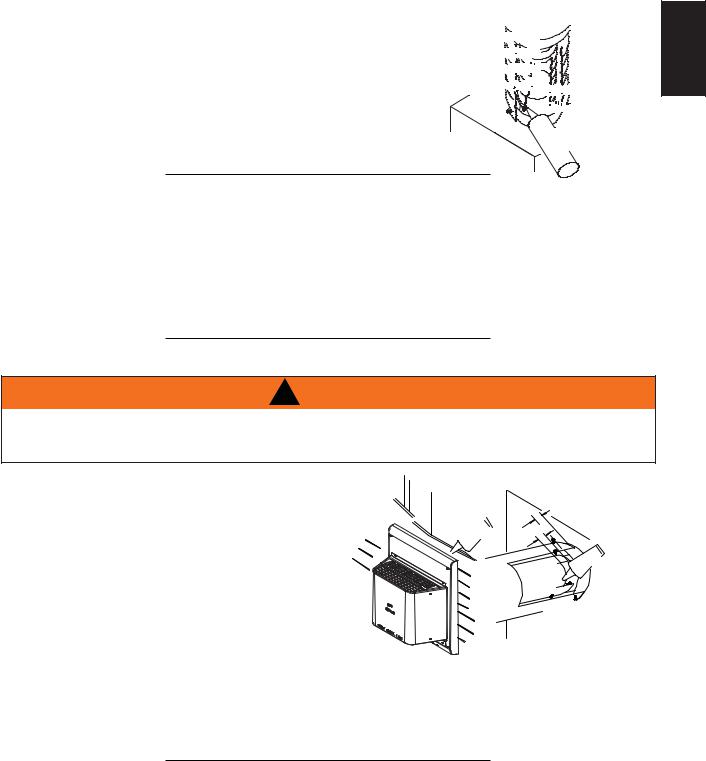
29
4.2.3APPLIANCE VENT CONNECTION
A.Install the inner exhaust flue collar to the appliance. Secure with 3 screws. Seal the joint and screw holes using the high temperature sealant Mill-Pac W573-0007 (not supplied).
B.Install the outer flex pipe to the appliance. Attach and seal the joints using a high temperature sealant.
#8 X 1/2”



 SELF
SELF





 DRILLING
DRILLING






SCREWS 




EN




 2” (50.8mm)
2” (50.8mm)





 OVERLAP
OVERLAP
HIGH TEMP
SEALANT
28.1C
4.3USING RIGID VENT COMPONENTS
The vent system must be supported approximately every 3 feet (0.9m) for both vertical and horizontal runs. Use Wolf Steel Ltd. support ring assembly or equivalent noncombustible strapping to maintain the minimum clearance to combustibles for both vertical and horizontal runs.
All inner exhaust and outer intake vent pipe joints may be sealed using either red high temperature silicone sealant W573-0002 (not supplied) or black high temperature sealant W573-0007 Mill Pac (not supplied) with the exception of the appliance exhaust flue collar which must be sealed using Mill Pac.
25.1A
4.3.1 HORIZONTAL AIR TERMINAL INSTALLATION
! WARNING
RISK OF FIRE, DO NOT ALLOW LOOSE MATERIALS OR INSULATION TO TOUCH THE VENT PIPE. REMOVE INSULATION TO ALLOW FOR THE INSTALLATION OF THE ATTIC SHIELD AND TO MAINTAIN CLEARANCES TO COMBUSTIBLES.
A.Move the appliance into position. Measure the
vent length required between terminal and |
#10x2" |
appliance taking into account the additional |
SCREWS |
length needed for the finished wall surface |
|
and any 1¼” (31.8mm) overlaps between |
|
venting components. |
|
B. Apply high temperature sealant W573-0007 (not supplied) to the outer edge of the inner exhaust flue collar of the appliance. Attach the first inner rigid pipe component and secure using 3 self tapping screws. Repeat using the outer rigid pipe.
|
1" (25.4mm) |
|
|
OVERLAP |
|
CAULKING |
|
|
|
INNER |
HI-TEMP |
|
SEALANT |
|
OUTER RIGID |
|
|
RIGID |
PIPE |
|
PIPE |
#8x1/2" |
|
|
SELF DRILLING |
|
|
SCREWS |
|
C.Insert the vent pipes through the firestop maintaining the required clearance to combustibles. Holding the air terminal (lettering in an upright, readable position), secure to the exterior wall and make weather tight by sealing with caulking (not supplied).
The air terminal mounting plate may be recessed into the exterior wall or siding no greater than the
depth of the return flange. |
26.1A |
|
W415-1401 / C / 03.18.15
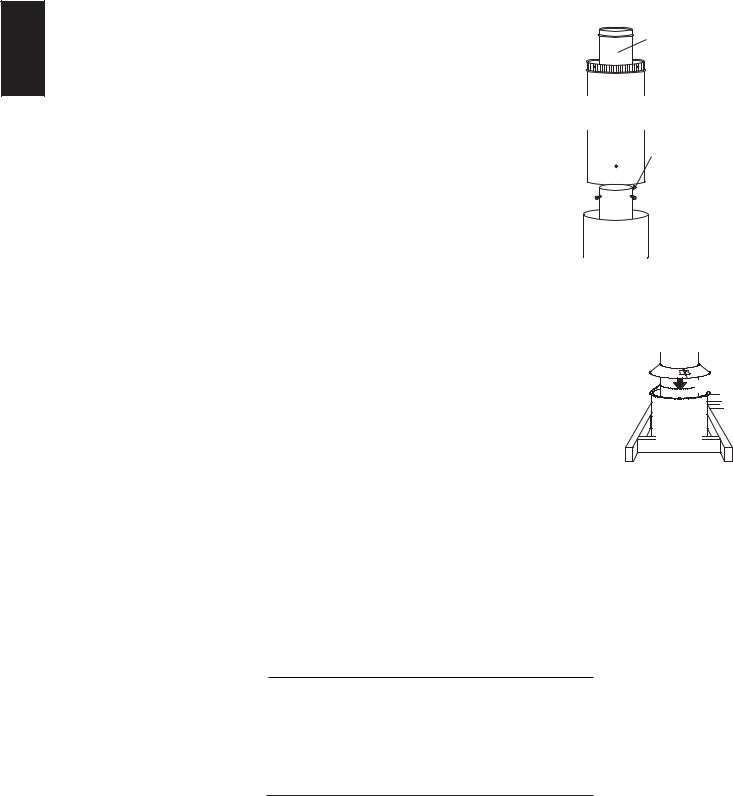
30
4.3.2 VERTICAL AIR TERMINAL INSTALLATION
|
A. |
Move the appliance into position. |
EN |
B. |
Fasten the roof support to the roof using the screws provided. The |
|
|
roof support is optional. In this case the venting is to be adequately |
|
|
supported using either an alternate method suitable to the authority |
|
C. |
having jurisdiction or the optional roof support. |
|
||
|
Apply high temperature sealant (not supplied) to the outer edge of |
|
|
|
the inner sleeve of the air terminal. Slip the inner coupler a minimum |
|
|
of 2" (51mm)over the sleeve and secure using 3 screws. |
|
D. |
Apply high temperature sealant (not supplied) to the outer edge of |
|
|
the of the outside sleeve of the air terminal connector. Slip the outer |
|
|
coupler over the sleeve and secure as before. Trim the outer coupler |
|
|
even with the inner coupler end. |
INNER PIPE
AIR
TERMINAL
CONNECTOR
E.Thread the air terminal connector / vent pipe assembly down through the roof support and attach, ensuring that a minimum 16" (406mm) of air terminal connector will penetrate the roof when fastened. If
the attic space is tight, we recommend threading the Wolf Steel vent pipe collar or equivalent loosely onto the air terminal connector / vent pipe assembly as it is passed through the attic. The air terminal connector must be located vertically and plumb.
F.Remove nails from the shingles, above and to the sides of the air terminal connector. Place the flashing over the air terminal connector and slide it underneath the sides and upper edge of the shingles. Ensure that the air terminal connector is properly centered within the flashing, giving a 3/4" (19mm) margin all around. Fasten to the roof. Do NOT nail through the lower portion of the flashing. Make weather-tight by sealing with caulking. Where possible, cover the sides and top edges of the flashing with roofing material.
VENT |
PIPE |
COLLAR |
VENT |
PIPE |
SHIELD |
G.Apply a heavy bead of waterproof caulking 2" (51mm) above the flashing.
Install the storm collar around the air terminal and slide down to the caulking. Tighten to ensure that a weather-tight seal between the air terminal connector and the collar is achieved.
H.Continue adding rigid venting sections, sealing and securing as above. Attach the inner collapsed telescopic sleeve to the last section of rigid piping. Secure with screws and seal. Repeat using the outer telescopic sleeve.
I.Run a bead of high temperature sealant (not supplied) around the outside of the inner exhaust flue collar on the appliance. Pull the telescopic sleeve a minimum of 2" (51mm) onto the collar. Secure with 3 screws. Repeat with the outer telescopic sleeve.
J.In the attic, slide the vent pipe collar down to cover up the open end of the shield and tighten. This will prevent any materials, such as insulation, from filling up the 1" (25mm) air space around the pipe.
27.2A
4.4 RESTRICTING VERTICAL VENTS
Vertical installations may display a very active flame. If this appearance is not desirable, the vent exit must be restricted using a restrictor vent kit. Refer to “ACCESORIES” in the “REPLACEMENTS” section for the
appropriate kit. This will reduce the velocity of the exhaust gases, slowing down the flame pattern and creating a more traditional gentle flame appearance. Specific instructions are included with the kit.
77.3
W415-1401 / C / 03.18.15
